Table of Contents
The UNESCO Sites in Spain have resulted from the recognition of 49 cultural and natural landmarks as UNESCO World Heritage Sites in Spain and 31 locations on the Spain UNESCO tentative list. These tourist sites in Spain are acknowledged for their unique and valuable cultural, natural, artistic, and historical significance and are preserved for future generations to enjoy.
In addition to these 49 sites on the Spain UNESCO list, there are many other places to travel to Spain that are being considered for UNESCO recognition. These sites, listed on the tentative list, showcase the rich cultural heritage of the country and are waiting for approval to join the prestigious and famous World Heritage Sites list.
To help visitors discover these remarkable Spain tourist attractions, we have put together an interactive map of the UNESCO sites in Spain.
Spain UNESCO Map
Click markers to show information and photo.
World Heritage Sites in Spain
UNESCO World Heritage Sites in Spain
There are 49 UNESCO World Heritage Sites in Spain. All of these three sites are listed under the Cultural category.
- Alhambra, Generalife and Albayzín, Granada
- Antequera Dolmens Site
- Aranjuez Cultural Landscape
- Archaeological Ensemble of Mérida
- Archaeological Ensemble of Tarraco
- Archaeological Site of Atapuerca
- Burgos Cathedral
- Caliphate City of Medina Azahara
- Catalan Romanesque Churches of the Vall de Boí
- Cathedral, Alcázar and Archivo de Indias in Seville
- Cave of Altamira and Paleolithic Cave Art of Northern Spain
- Cultural Landscape of the Serra de Tramuntana
- Heritage of Mercury. Almadén and Idrija
- Historic Centre of Cordoba
- Historic City of Toledo
- Historic Walled Town of Cuenca
- La Lonja de la Seda de Valencia
- Las Médulas
- Monastery and Site of the Escurial, Madrid
- Monuments of Oviedo and the Kingdom of the Asturias
- Mudejar Architecture of Aragon
- Old City of Salamanca
- Old Town of Ávila with its Extra-Muros Churches
- Old Town of Cáceres
- Old Town of Segovia and its Aqueduct
- Palau de la Música Catalana and Hospital de Sant Pau, Barcelona
- Palmeral of Elche
- Paseo del Prado and Buen Retiro, a landscape of Arts and Sciences
- Poblet Monastery
- Prehistoric Rock Art Sites in the Côa Valley and Siega Verde
- Renaissance Monumental Ensembles of Úbeda and Baeza
- Risco Caido and the Sacred Mountains of Gran Canaria Cultural Landscape
- Rock Art of the Mediterranean Basin on the Iberian Peninsula
- Roman Walls of Lugo
- Routes of Santiago de Compostela: Camino Francés and Routes of Northern Spain
- Royal Monastery of Santa María de Guadalupe
- San Cristóbal de La Laguna
- San Millán Yuso and Suso Monasteries
- Santiago de Compostela (Old Town)
- Tower of Hercules
- University and Historic Precinct of Alcalá de Henares
- Vizcaya Bridge
- Works of Antoni Gaudí
- Ancient and Primeval Beech Forests of the Carpathians and Other Regions of Europe
- Doñana National Park
- Garajonay National Park
- Teide National Park
- Ibiza, Biodiversity and Culture
- Pyrénées – Mont Perdu
UNESCO World Heritage Sites in Spain are protected locations for their cultural and natural importance.
Alhambra, Generalife and Albayzín, Granada
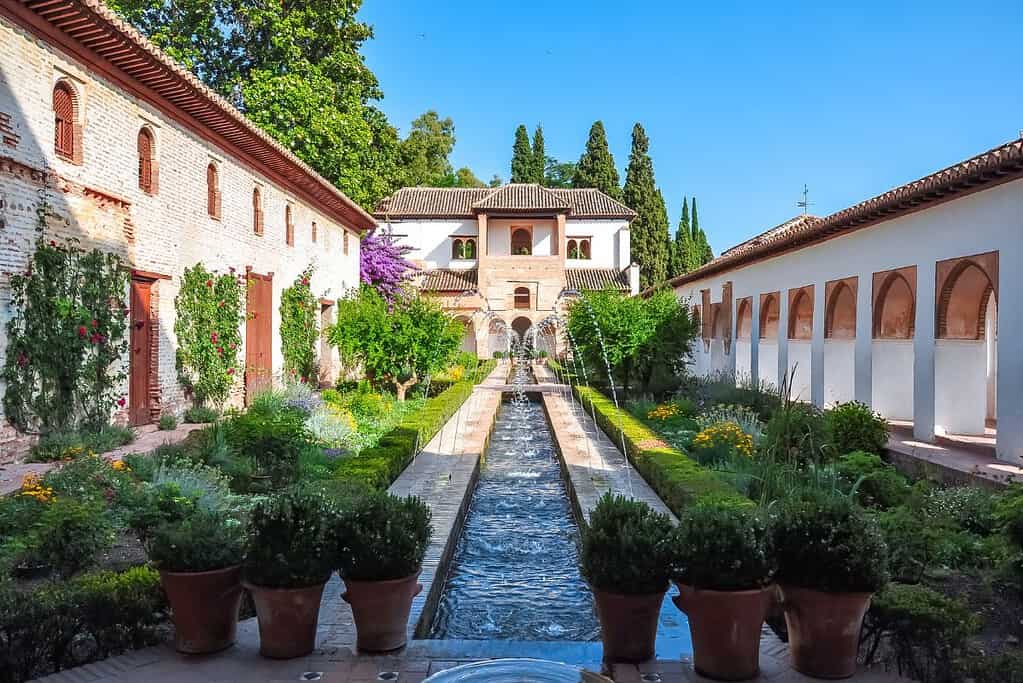
The Alhambra, Generalife, and Albayzín in Granada, Spain, are collectively designated as UNESCO World Heritage Site. This remarkable complex showcases the harmonious fusion of Islamic and Christian influences throughout history. The Alhambra, a stunning fortress and palace, is a testament to the splendor of the Nasrid dynasty. Its intricate architectural details, including delicate stucco work and mesmerizing tile patterns, are a feast for the eyes. Adjacent to the Alhambra, the Generalife presents enchanting gardens adorned with vibrant flowers, tranquil courtyards, and refreshing water features. Finally, the Albayzín, a charming medieval neighborhood, offers winding streets, picturesque squares, and a captivating atmosphere that reflects the city’s diverse cultural heritage. Together, these sites embody the rich history and exquisite beauty of Granada.
Antequera Dolmens Site
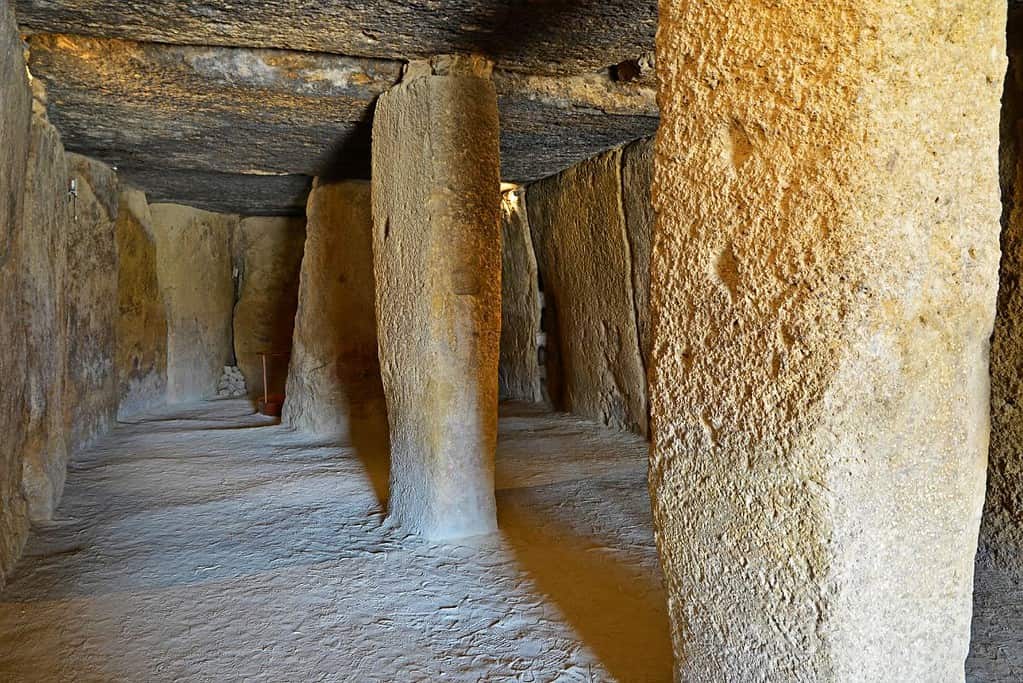
The Antequera Dolmens Site is a UNESCO World Heritage Site in Antequera, Spain. It is an exceptional archaeological complex with three megalithic monuments: the Menga Dolmen, the Viera Dolmen, and the Romeral Dolmen. These dolmens, dating back to the Neolithic period, are impressive examples of prehistoric architecture and burial sites. The site provides valuable insights into the rituals and beliefs of the ancient people who built them. With its monumental stone structures, the Antequera Dolmens Site is a captivating destination for those interested in the region’s ancient history and cultural heritage.
Aranjuez Cultural Landscape
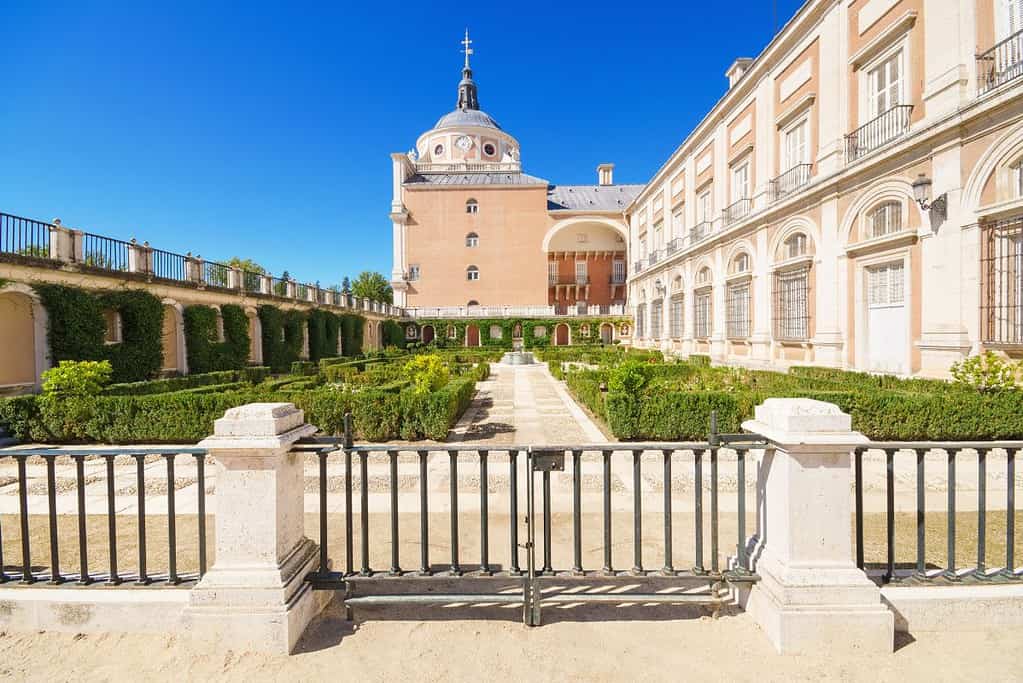
The Aranjuez Cultural Landscape is a UNESCO World Heritage Site located in Spain. This remarkable landscape showcases the harmonious fusion of nature and human creativity. Situated on the banks of the Tagus River, Aranjuez boasts magnificent gardens, impressive architecture, and a rich cultural heritage. The Royal Palace of Aranjuez, with its elegant façade and opulent interiors, serves as the centerpiece of this landscape. Surrounding the palace are beautifully designed gardens, such as the Parterre Garden and the Island Garden, adorned with fountains, sculptures, and vibrant flora. The landscape also includes agricultural areas and the historic town of Aranjuez, which offers a glimpse into the region’s history and traditional way of life. The Aranjuez Cultural Landscape is a captivating testament to the intersection of art, nature, and human ingenuity.
Archaeological Ensemble of Mérida
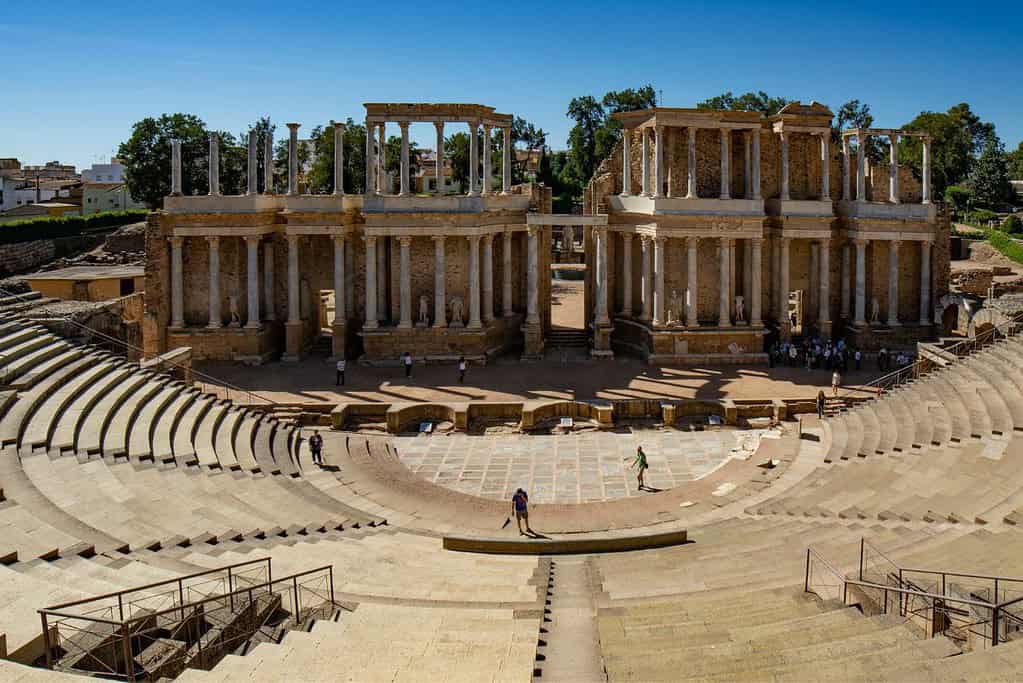
The Archaeological Ensemble of Mérida is a UNESCO World Heritage Site in Mérida, Spain. It showcases the impressive remains of the ancient Roman city of Emerita Augusta, founded in 25 BC. The ensemble includes well-preserved structures such as the stunning Roman Theatre, the Amphitheatre, and the Aqueduct of Los Milagros. These architectural marvels provide a glimpse into the rich history and grandeur of the Roman Empire. Visitors to the site can explore the intricate mosaics, impressive columns, and other fascinating archaeological finds, immersing themselves in the legacy of this ancient civilization. The Archaeological Ensemble of Mérida stands as a testament to the cultural and historical significance of the Roman era in the region.
Archaeological Ensemble of Tarraco
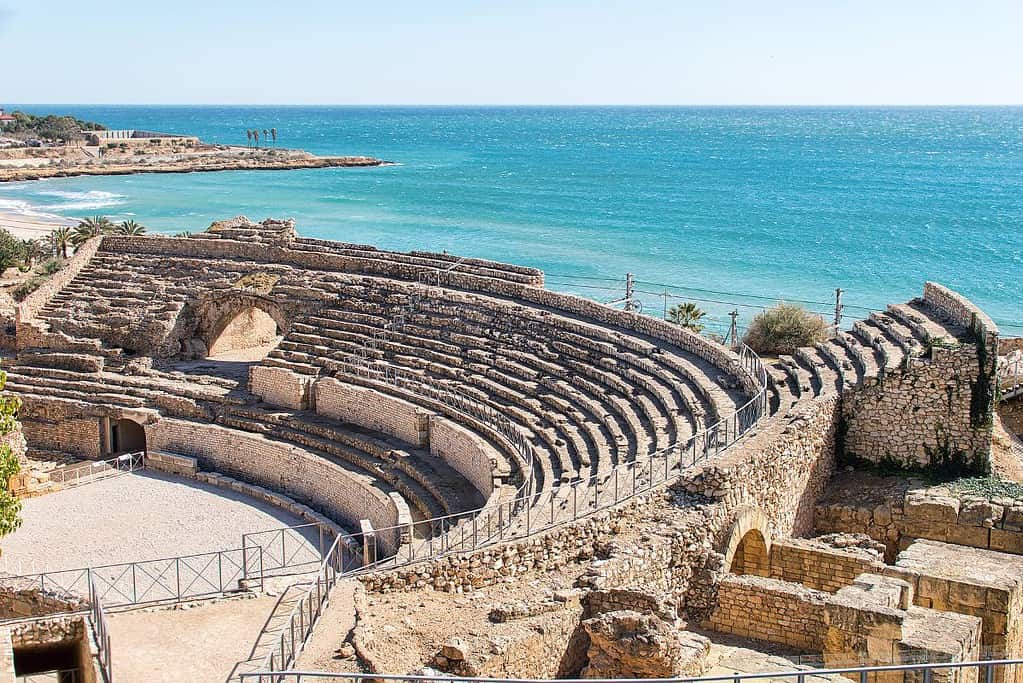
The Archaeological Ensemble of Tarraco is a UNESCO World Heritage Site in Tarragona, Spain. It showcases the remains of an ancient Roman city once the capital of the Roman province of Hispania Citerior. The ensemble includes impressive structures such as the amphitheater, the Roman circus, and the forum, which provide valuable insights into the urban planning and architectural prowess of the Roman Empire. The site also features well-preserved Roman walls and various residential buildings, offering visitors a glimpse into the daily life of the city’s inhabitants. The Archaeological Ensemble of Tarraco stands as a testament to the region’s rich historical and cultural heritage.
Archaeological Site of Atapuerca
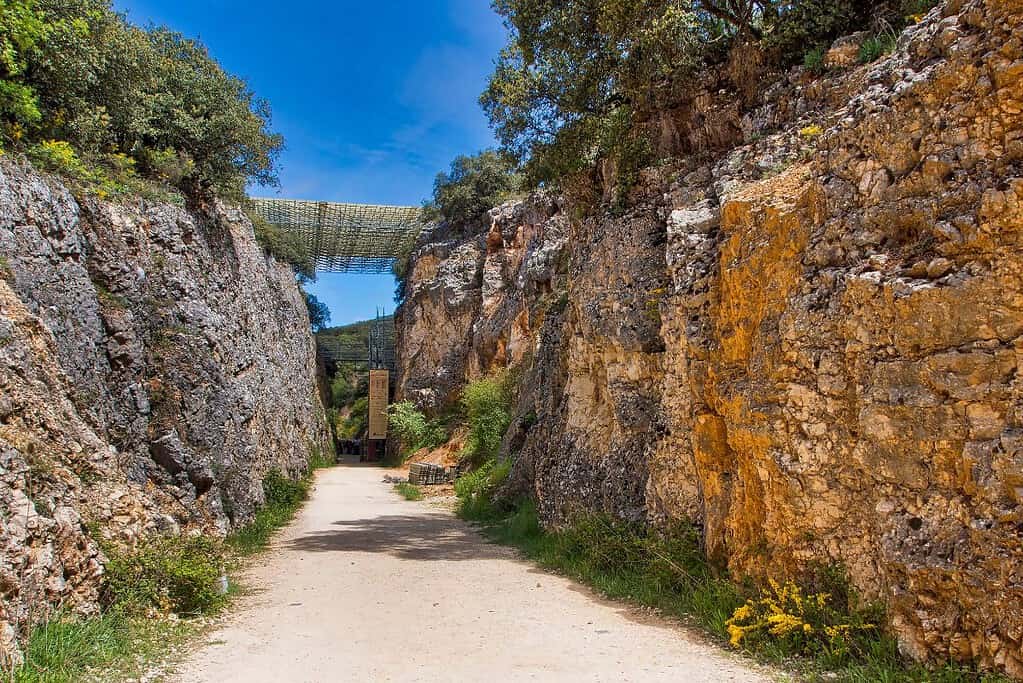
The Archaeological Site of Atapuerca is a renowned UNESCO World Heritage Site in Spain. Situated near the town of Atapuerca in the province of Burgos, this site is of immense significance in understanding human evolution and prehistoric cultures. The excavations carried out here have unearthed numerous fossils and artifacts dating back hundreds of thousands of years, providing valuable insights into the lives and behaviors of our ancient ancestors. The site is particularly renowned for discovering Homo antecessor, one of the earliest known human species in Europe. The Archaeological Site of Atapuerca stands as a remarkable testament to the rich history that unfolded in this region and continues to contribute to our understanding of human origins.
Burgos Cathedral
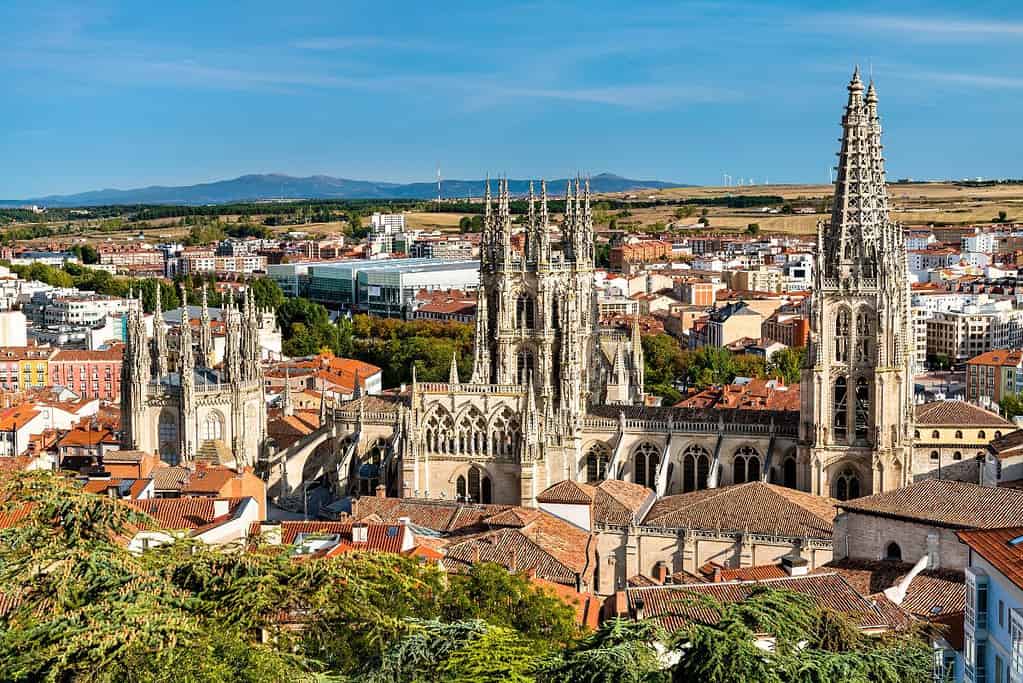
Burgos Cathedral, a UNESCO World Heritage Site located in Burgos, Spain, is an architectural masterpiece and a symbol of Gothic art. The cathedral, dedicated to Saint Mary, impresses visitors with its grandeur and intricate detailing. Its soaring spires, elegant flying buttresses, and ornate facade make it a true gem of medieval architecture. Visitors can marvel at the stunning stained glass windows, imposing pillars, and beautifully sculpted Choir stalls. Burgos Cathedral is a testament to the skill and creativity of the craftsmen who worked on its construction, leaving a lasting impression on all who visit.
Caliphate City of Medina Azahara
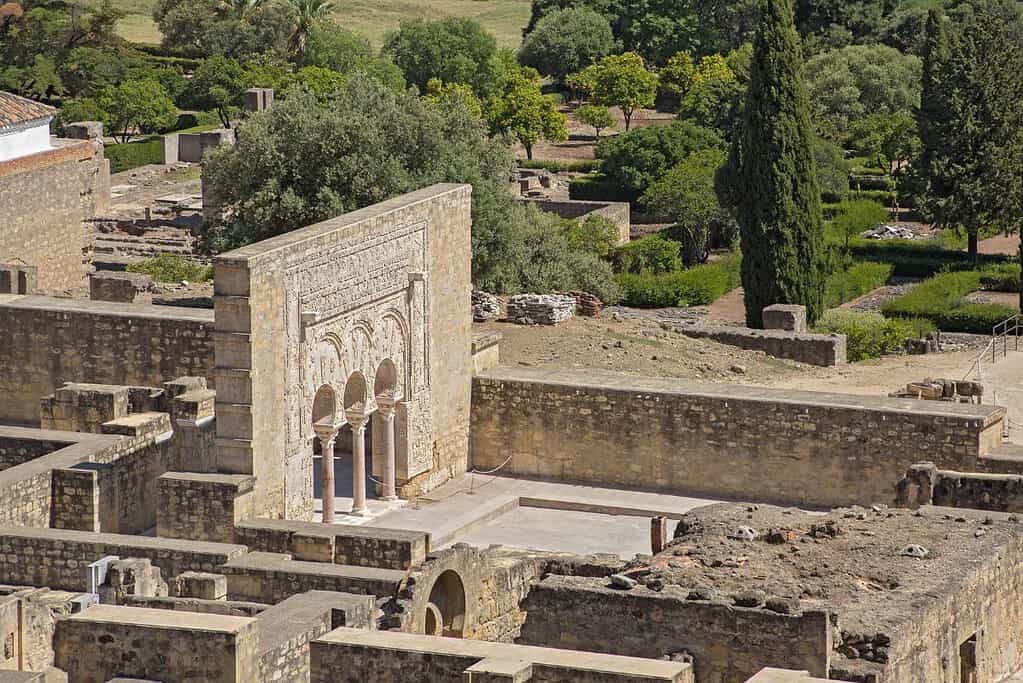
The Caliphate City of Medina Azahara is a UNESCO World Heritage Site in Spain. It was built in the 10th century as the ceremonial center of the Umayyad Caliphate of Cordoba. The city showcases the grandeur and sophistication of that era’s Islamic architecture and urban planning. Medina Azahara features impressive palaces, administrative buildings, and extensive public spaces adorned with intricate decorative elements. The site offers a glimpse into Islamic Spain’s cultural and artistic achievements, showcasing its rich history and heritage.
Catalan Romanesque Churches of the Vall de Boí
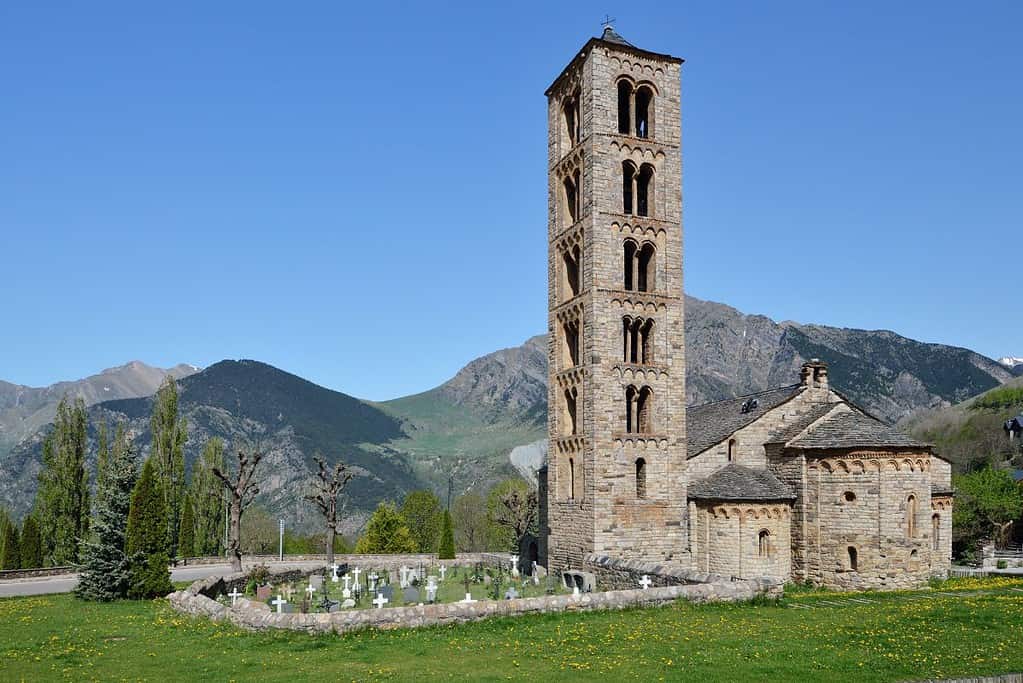
The Catalan Romanesque Churches of the Vall de Boí is a UNESCO World Heritage Site in Catalonia, Spain. Nestled in the picturesque Vall de Boí, these churches are exceptional examples of Romanesque architecture and artistry. The site comprises nine churches, including the Sant Climent de Taüll, Santa Maria de Taüll, and Sant Joan de Boí. These churches showcase remarkable frescoes and intricate sculptural details that reflect the region’s rich cultural and artistic heritage. With their harmonious blend of architectural beauty and religious significance, the Catalan Romanesque Churches of the Vall de Boí is a captivating testament to medieval Catalonia’s artistic and historical legacy.
Cathedral, Alcázar and Archivo de Indias in Seville
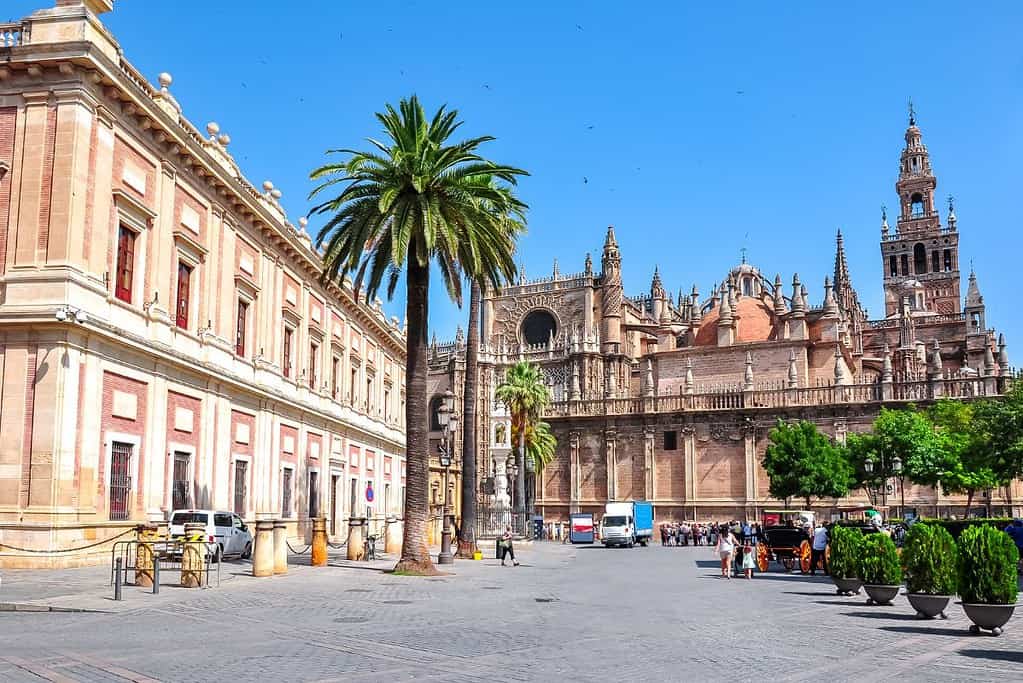
The Cathedral, Alcázar, and Archivo de Indias in Seville, Spain, collectively form a UNESCO World Heritage Site. The Cathedral of Seville, known as Catedral de Santa María de la Sede, is the largest Gothic cathedral in the world and boasts impressive architectural features, including the iconic Giralda Bell Tower. The Alcázar of Seville is a magnificent royal palace that showcases a blend of Moorish and Christian influences in its stunning design and beautifully landscaped gardens. Lastly, the Archivo de Indias, an archival repository, houses valuable historical documents related to the Spanish colonization of the Americas. These three structures represent Seville’s rich cultural and historical heritage and are must-see attractions for visitors worldwide.
Cave of Altamira and Paleolithic Cave Art of Northern Spain
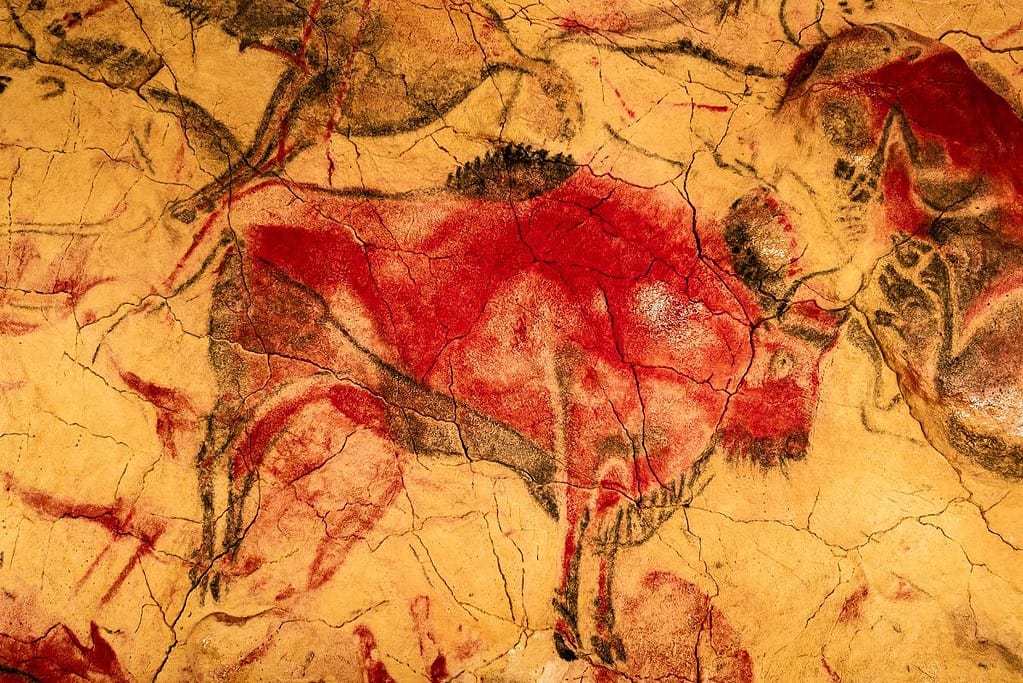
The Cave of Altamira and Paleolithic Cave Art of Northern Spain is a UNESCO World Heritage Site in Cantabria, Spain. This extraordinary site houses some of the world’s most significant and well-preserved examples of Paleolithic cave art. The cave art, dating back over 35,000 years, consists of vivid paintings and engravings depicting animals, human figures, and abstract symbols. These artworks’ intricate details and remarkable preservation provide valuable insights into our ancient ancestors’ lives and artistic abilities. The Cave of Altamira and the Paleolithic Cave Art of Northern Spain stand as a testament to the rich cultural heritage of early human civilization and the power of artistic expression across millennia.
Cultural Landscape of the Serra de Tramuntana
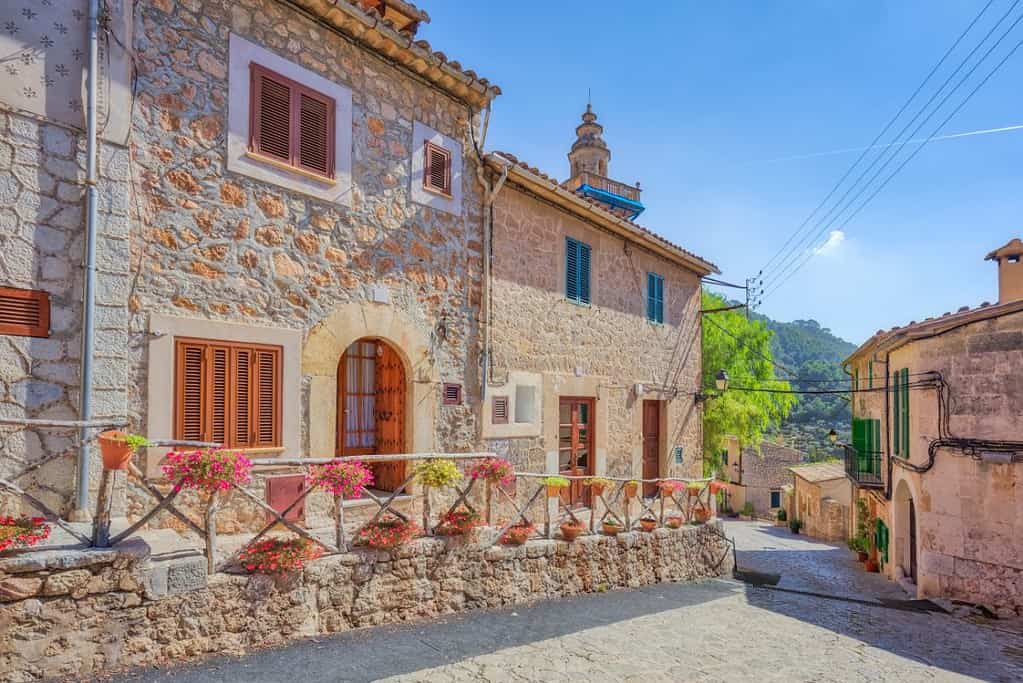
The Cultural Landscape of the Serra de Tramuntana is a UNESCO World Heritage Site in the Balearic Islands, Spain. This stunning landscape encompasses the Serra de Tramuntana mountain range, which stretches along the northwest coast of the island of Mallorca. The site is renowned for its exceptional beauty, characterized by rugged peaks, deep valleys, and terraced agriculture. The cultural significance of this landscape lies in its harmonious blend of human activity with the natural environment. The terraces, ancient irrigation systems, and traditional stone houses showcase the long-standing agricultural traditions of the region. The Serra de Tramuntana is a remarkable natural setting and a testament to the profound relationship between humans and their environment over centuries, making it a captivating and culturally significant destination.
Heritage of Mercury. Almadén and Idrija
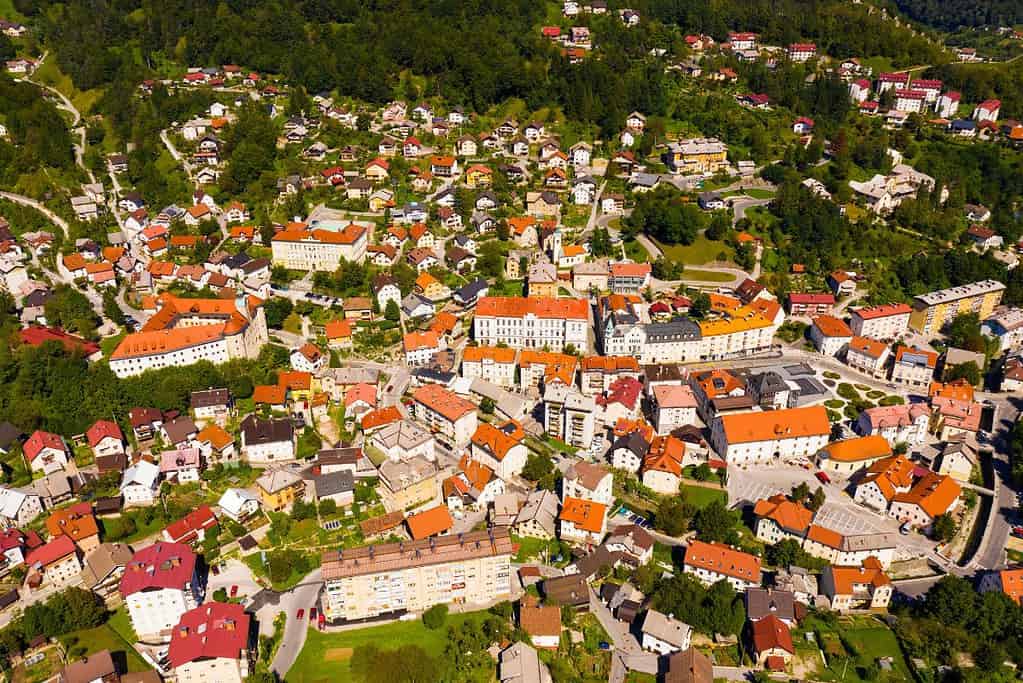
The Heritage of Mercury. Almadén and Idrija are UNESCO World Heritage Site that showcases the rich history and significance of mercury mining in two prominent locations: Almadén in Spain and Idrija in Slovenia. These sites were instrumental in the global production of mercury, which played a vital role in various industries and scientific advancements. The mines, infrastructure, and cultural heritage associated with mercury extraction are well-preserved in both Almadén and Idrija, providing visitors with a unique insight into the technological, economic, and social aspects of this important historical activity. The site is a testament to the global impact of mercury mining and its profound influence on human civilization.
Historic Centre of Cordoba
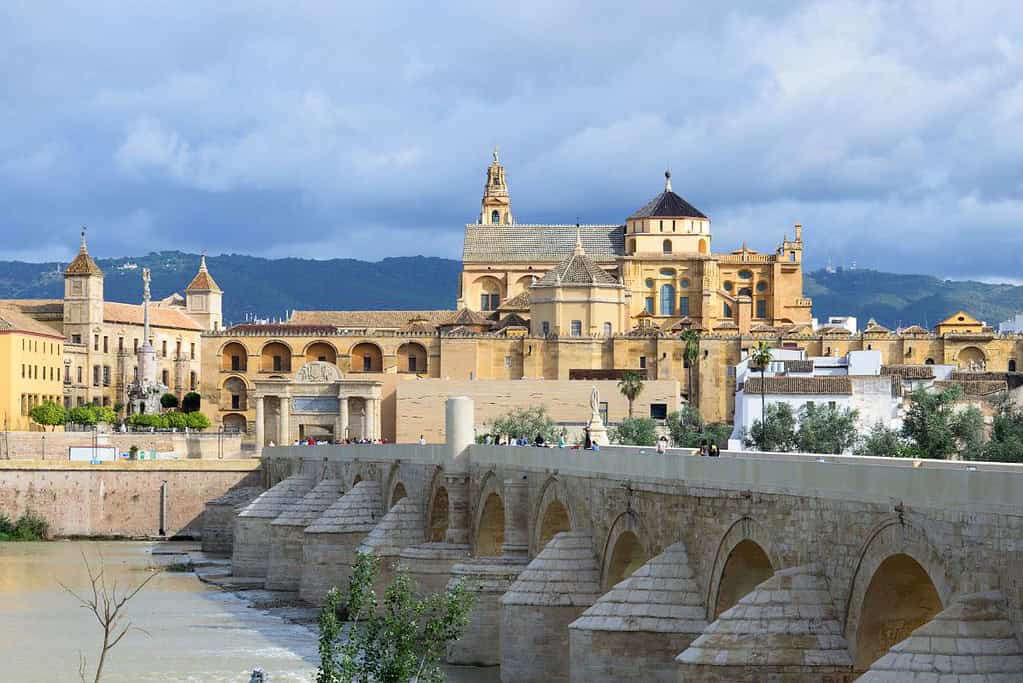
The Historic Centre of Cordoba is a UNESCO World Heritage Site in Cordoba, Spain. It showcases a rich blend of architectural styles and cultural influences from various civilizations that have shaped the city’s history. At its heart lies the magnificent Great Mosque of Cordoba, also known as the Mezquita, a stunning example of Islamic architecture with its iconic horseshoe arches and intricate geometric patterns. Surrounding the mosque, the historic center is filled with narrow, winding streets lined with whitewashed buildings adorned with colorful flower-filled patios. The Roman Bridge spanning the Guadalquivir River adds charm, connecting the old town to the modern city. The Historic Centre of Cordoba is a testament to the city’s multicultural heritage and a captivating destination for visitors seeking to immerse themselves in its fascinating history.
Historic City of Toledo
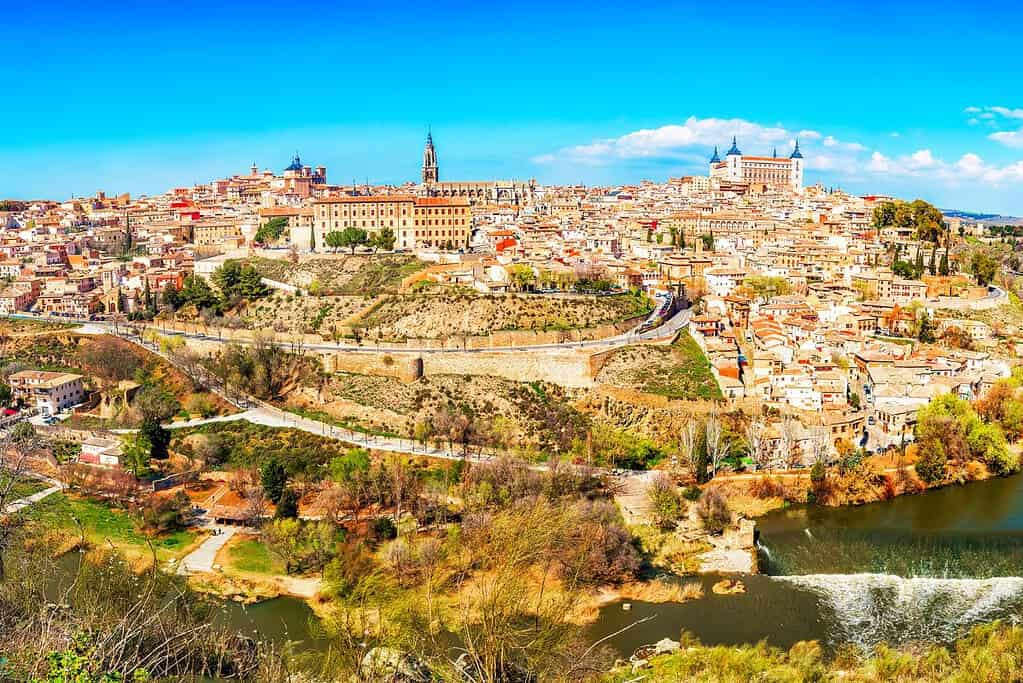
The Historic City of Toledo is a UNESCO World Heritage Site in Spain. This magnificent city is perched on a hill overlooking the Tagus River, and its rich history dates back to Roman times. Known as the “City of Three Cultures,” Toledo showcases a remarkable blend of Christian, Muslim, and Jewish influences. Its historic center is a treasure trove of architectural wonders, including the stunning Toledo Cathedral, the Alcázar fortress, and numerous medieval synagogues and mosques. Wandering through its narrow, winding streets reveals hidden gems at every turn, with ancient walls, charming plazas, and picturesque views that transport visitors back in time. The Historic City of Toledo is a testament to centuries of cultural exchange and is a true delight for history and architecture enthusiasts.
Historic Walled Town of Cuenca
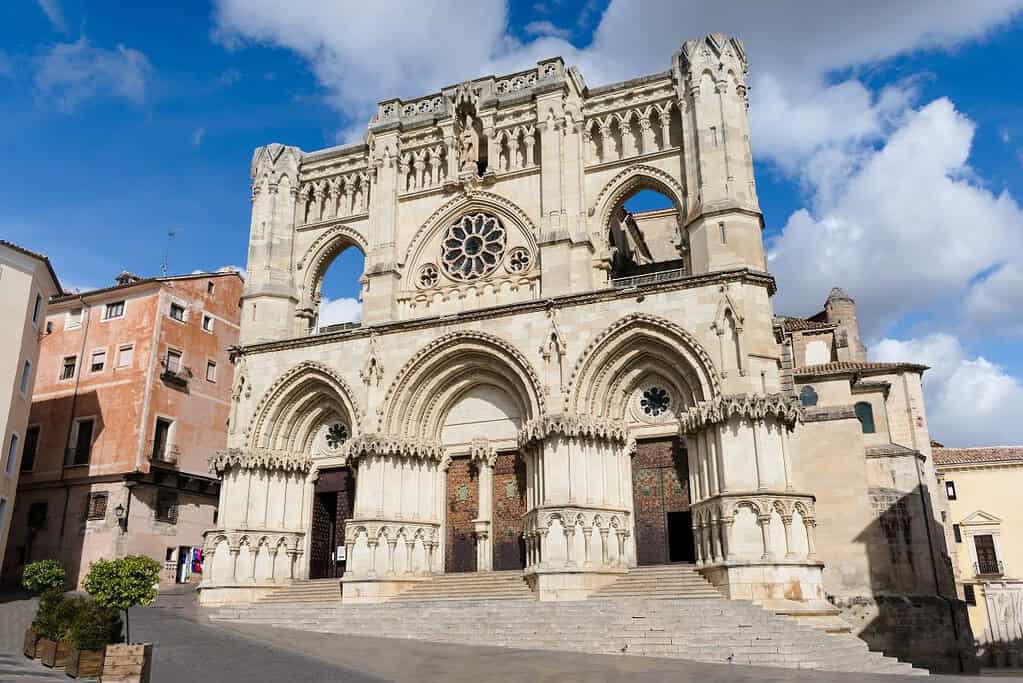
The Historic Walled Town of Cuenca is a UNESCO World Heritage Site in Spain. The town is situated on a rocky spur above the Huécar and Júcar rivers, showcasing an exceptional example of medieval fortified architecture. The well-preserved walled area features narrow streets, historic buildings, and impressive structures such as the Cuenca Cathedral and the Hanging Houses, which seem to cling to the cliffside. With its rich history and picturesque setting, the Historic Walled Town of Cuenca offers visitors a captivating glimpse into the medieval past of this enchanting Spanish town.
La Lonja de la Seda de Valencia

La Lonja de la Seda de Valencia, also known as the Silk Exchange, is a UNESCO World Heritage Site in Valencia, Spain. Built-in the 15th century, it is a stunning example of Gothic civil architecture and served as a major center for silk trading during the height of the Valencia Silk Road. The building’s intricate design features ornate columns, ribbed vaults, and detailed carvings, showcasing the wealth and influence of the city’s mercantile past. Today, La Lonja de la Seda is a testament to Valencia’s rich history and is a must-visit destination for admirers of architectural beauty and cultural heritage.
Las Médulas
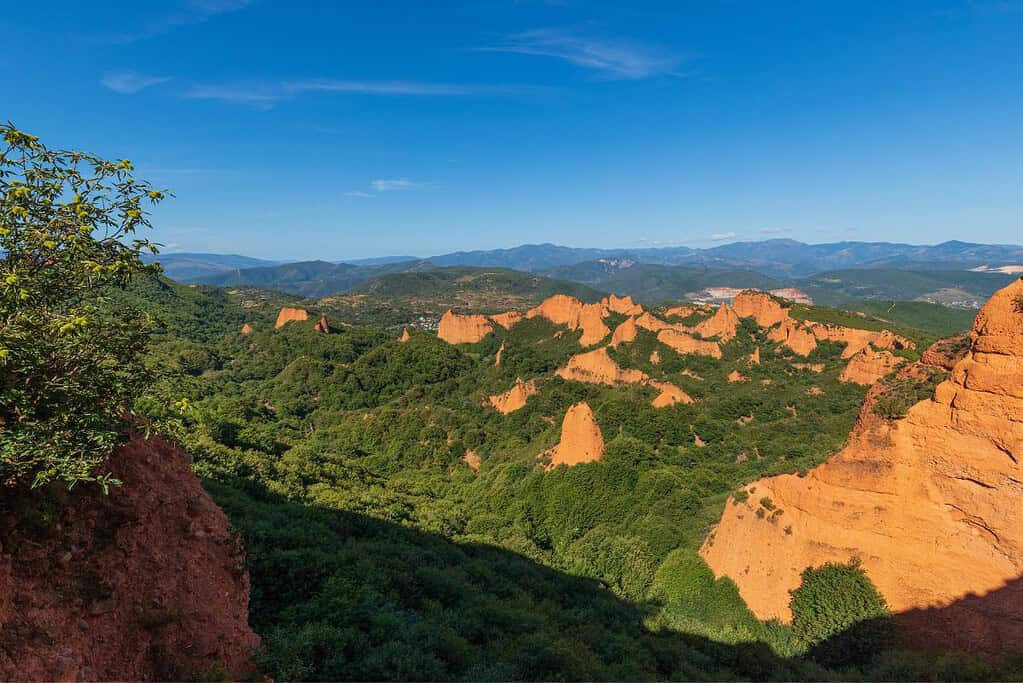
Las Médulas is a captivating UNESCO World Heritage Site located in Spain. This mesmerizing landscape showcases the remnants of an ancient Roman gold mining operation dating back to the 1st century AD. The site is renowned for its stunning red cliffs and unique rock formations formed by centuries of mining activity. Visitors can explore the network of tunnels and admire the impressive terraces carved into the hillsides, a testament to the ingenuity of the Roman engineers. Las Médulas offers a fascinating glimpse into the rich history and remarkable engineering achievements of the Roman Empire.
Monastery and Site of the Escurial, Madrid
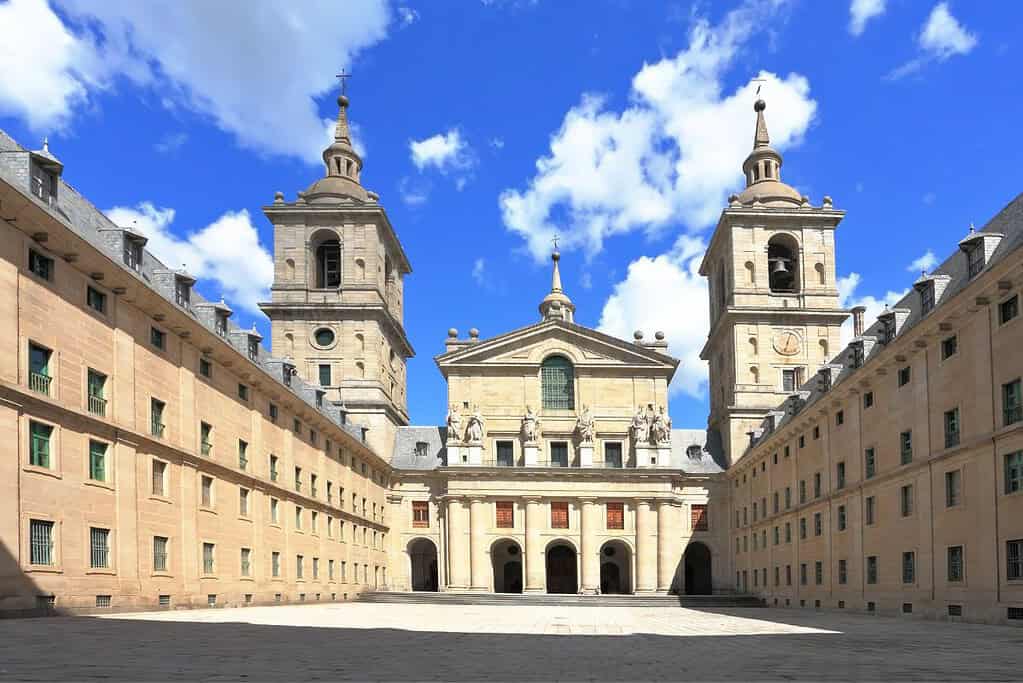
The Monastery and Site of the Escurial, located in Madrid, is a UNESCO World Heritage Site of great historical and cultural significance. It is an impressive architectural complex called El Escorial, including a monastery, royal palace, and library. Built during the reign of King Philip II in the 16th century, the site served as a symbol of Spanish power and influence. It showcases the mastery of Renaissance and Spanish Baroque styles, with its grandeur reflected in its ornate decorations, beautiful gardens, and stunning artwork. The Monastery and Site of the Escurial stand as a testament to Spain’s artistic and cultural heritage, attracting visitors from around the world.
Monuments of Oviedo and the Kingdom of the Asturias
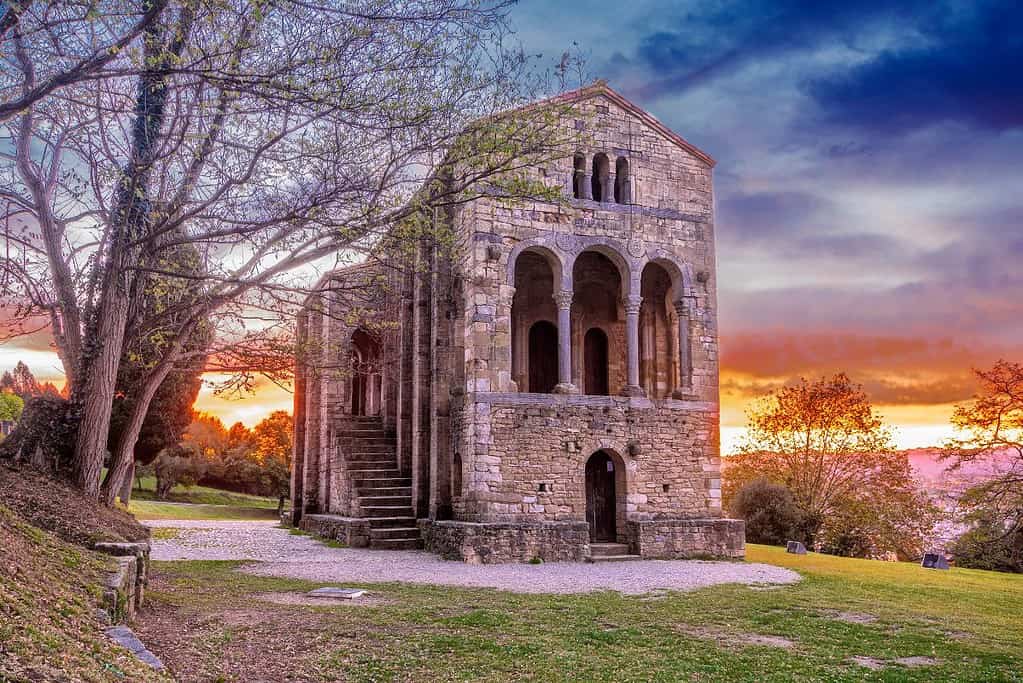
The Monuments of Oviedo and the Kingdom of the Asturias is a UNESCO World Heritage Site in northern Spain. This site encompasses remarkable historical landmarks reflecting the region’s rich cultural and architectural heritage. The monuments include the Oviedo Cathedral, a magnificent Gothic structure dating back to the 14th century, renowned for its stunning rose window and intricate sculptures. Another prominent landmark is the Church of San Julián de los Prados, an early medieval church featuring intricate pre-Romanesque designs and exquisite frescoes. These monuments stand as a testament to the artistic and architectural achievements of the Kingdom of the Asturias, making it a must-visit destination for history and culture enthusiasts.
Mudejar Architecture of Aragon
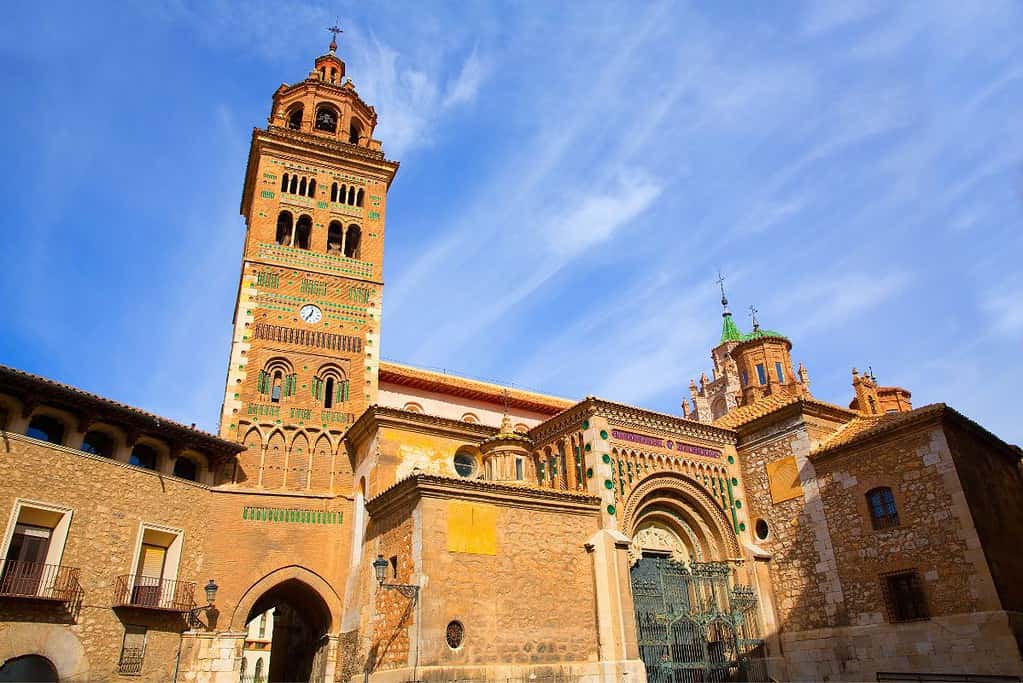
The Mudejar Architecture of Aragon is a UNESCO World Heritage Site in Aragon, Spain. This unique architectural style emerged during the medieval period, combining Islamic and Christian influences. The site showcases a remarkable collection of churches, towers, palaces, and city walls that blend Islamic art and Gothic architecture elements beautifully. These structures witness the region’s cultural exchange and coexistence of different religious and artistic traditions. The Mudejar Architecture of Aragon is a testament to the rich multicultural heritage of Spain and stands as a captivating example of architectural synthesis.
Old City of Salamanca
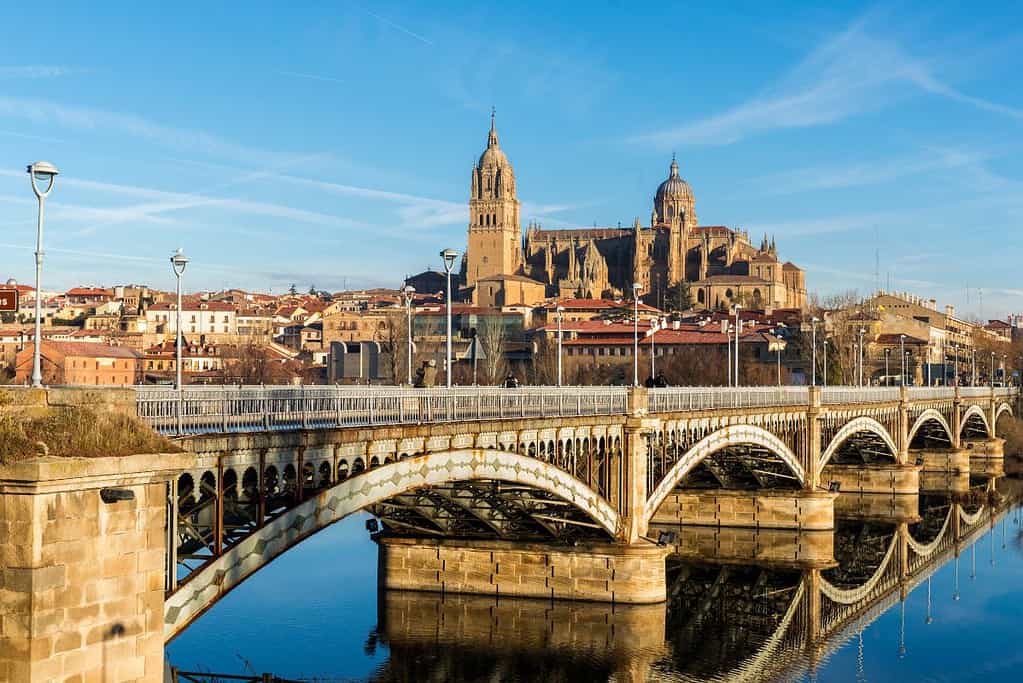
The Old City of Salamanca, located in Spain, is a UNESCO World Heritage Site renowned for its rich history and architectural treasures. This enchanting city is home to one of the oldest universities in Europe, the prestigious University of Salamanca, which dates back to the 13th century. The streets and squares of the Old City are lined with magnificent buildings, showcasing various architectural styles, including Romanesque, Gothic, Renaissance, and Baroque. The iconic Plaza Mayor stands as the city’s heart with its stunning facades and vibrant atmosphere. Visitors can explore remarkable landmarks such as the Salamanca Cathedral, the Casa de las Conchas adorned with unique shell-shaped ornaments, and the intricate Universidad Pontificia façade. The Old City of Salamanca captivates with its timeless charm and serves as a living testament to the city’s cultural and intellectual legacy.
Old Town of Ávila with its Extra-Muros Churches
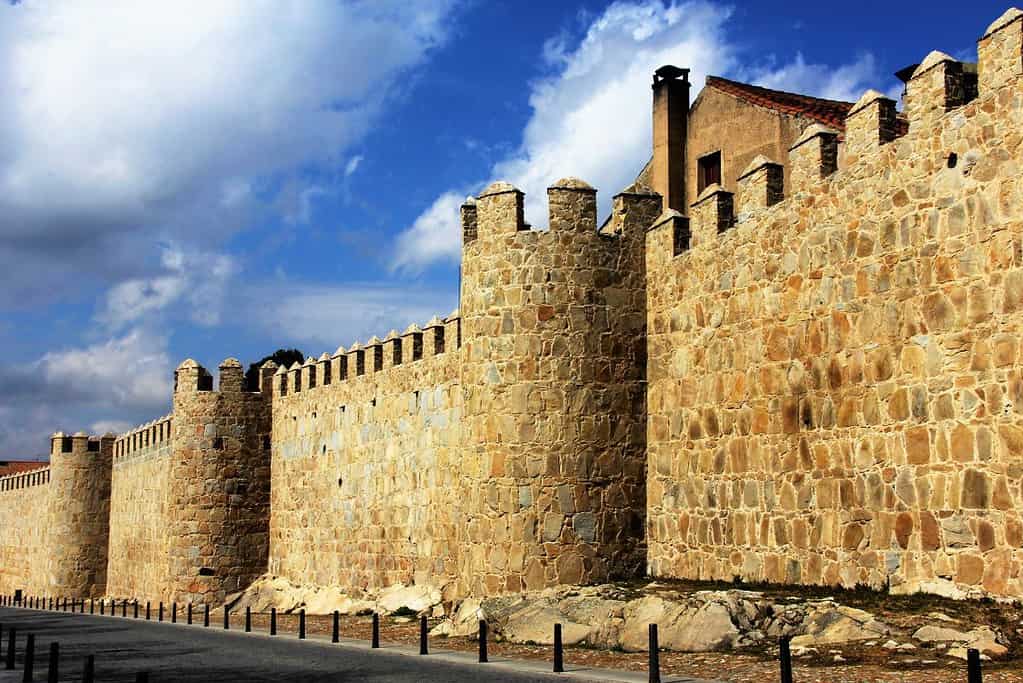
The Old Town of Ávila with its Extra-Muros Churches, is a UNESCO World Heritage Site in Ávila, Spain. This remarkable site is renowned for its well-preserved medieval city walls surrounding the historic center. The town’s architectural heritage is highlighted by its Extra-Muros Churches, such as the Basilica of San Vicente and the Church of San Pedro. These churches exhibit stunning Romanesque and Gothic styles, showcasing intricate details and impressive craftsmanship. Walking through the narrow streets of the Old Town, visitors can immerse themselves in the rich history and unique atmosphere of Ávila, experiencing the charm of this exceptional UNESCO site.
Old Town of Cáceres
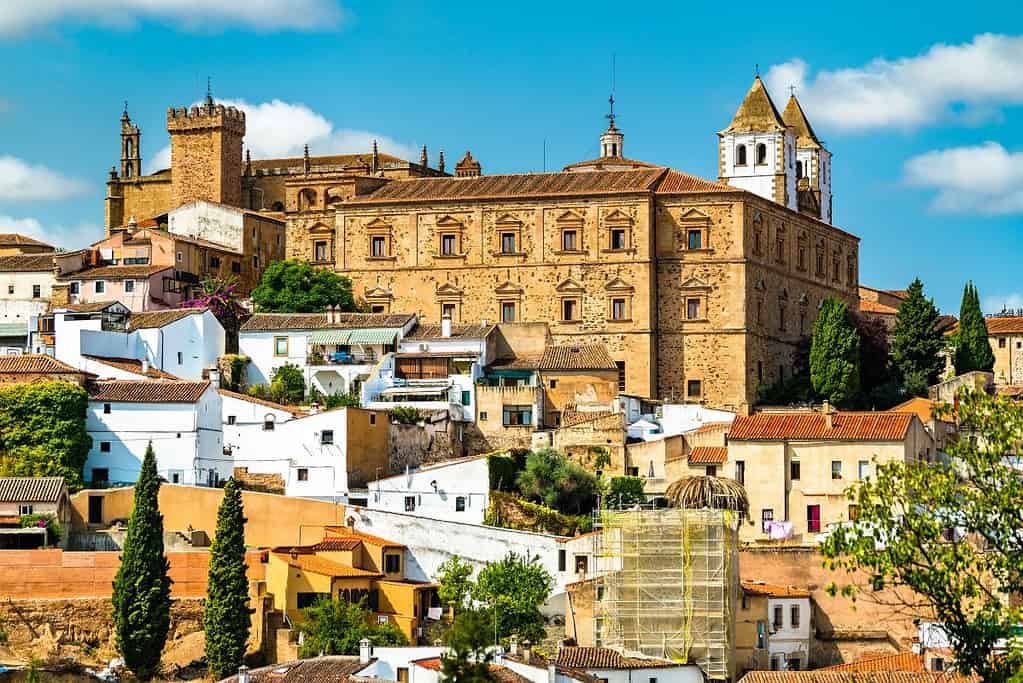
The Old Town of Cáceres is a UNESCO World Heritage Site in Cáceres, Spain. This historic town is renowned for its exceptionally well-preserved medieval architecture, which reflects a harmonious blend of Roman, Islamic, Northern Gothic, and Italian Renaissance styles. As you stroll through the narrow, cobblestone streets, you’ll encounter stunning palaces, fortified towers, and charming squares. The town’s impressive defensive walls, dating back to the 12th century, further enhance its unique character. The Old Town of Cáceres offers visitors a captivating journey back in time, immersing them in this enchanting Spanish gem’s rich history and cultural heritage.
Old Town of Segovia and its Aqueduct
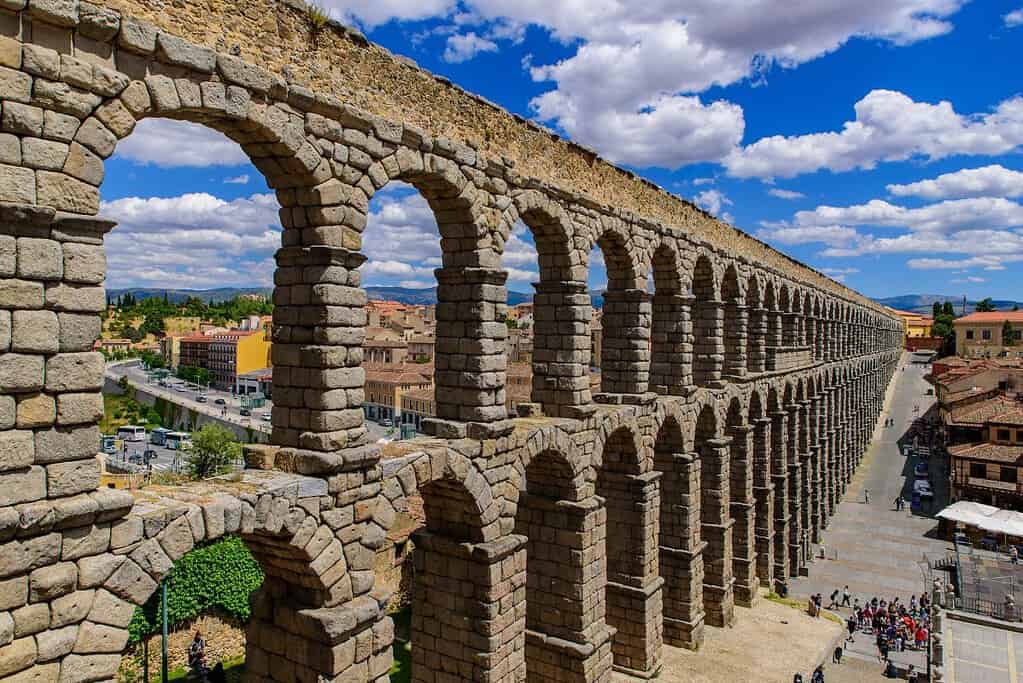
The Old Town of Segovia and its Aqueduct is a UNESCO World Heritage Site in Spain. This historic town showcases a remarkable blend of architectural styles, including Roman, Gothic, and Renaissance. The iconic aqueduct, dating back to the 1st century AD, is a testament to Roman engineering and symbolizes Segovia. The Old Town has numerous well-preserved buildings, such as the magnificent Segovia Cathedral, the Alcázar of Segovia castle, and charming medieval streets lined with picturesque houses. With its rich history and architectural treasures, the Old Town of Segovia is a captivating destination for visitors worldwide.
Palau de la Música Catalana and Hospital de Sant Pau, Barcelona
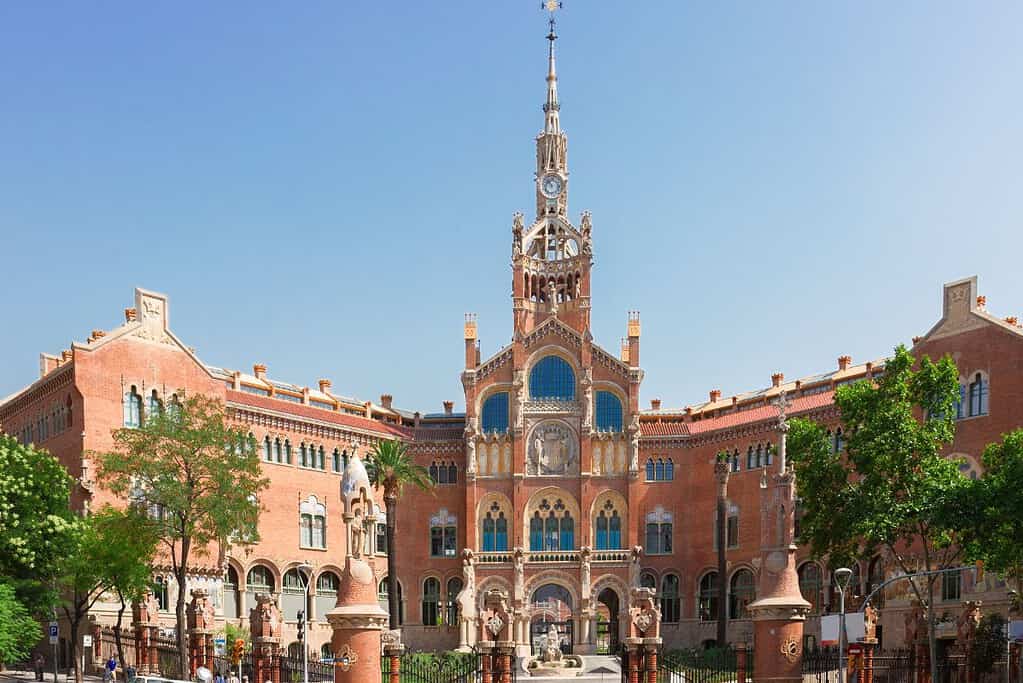
Palau de la Música Catalana and Hospital de Sant Pau, located in Barcelona, Spain, are two magnificent UNESCO World Heritage Sites that showcase Catalonia’s rich architectural and cultural heritage. Palau de la Música Catalana is a stunning concert hall designed by the renowned architect Lluís Domènech i Montaner. It is known for its intricate stained glass windows, decorative mosaics, and ornate sculptures, creating a truly enchanting atmosphere for music lovers. Hospital de Sant Pau, on the other hand, is a remarkable complex that exemplifies modernist architecture. Designed by Domènech i Montaner as well, it was originally a fully functioning hospital and is now a remarkable cultural center. Both sites beautifully embody Catalonia’s artistic and architectural prowess, drawing visitors worldwide to experience their exceptional beauty and historical significance.
Palmeral of Elche
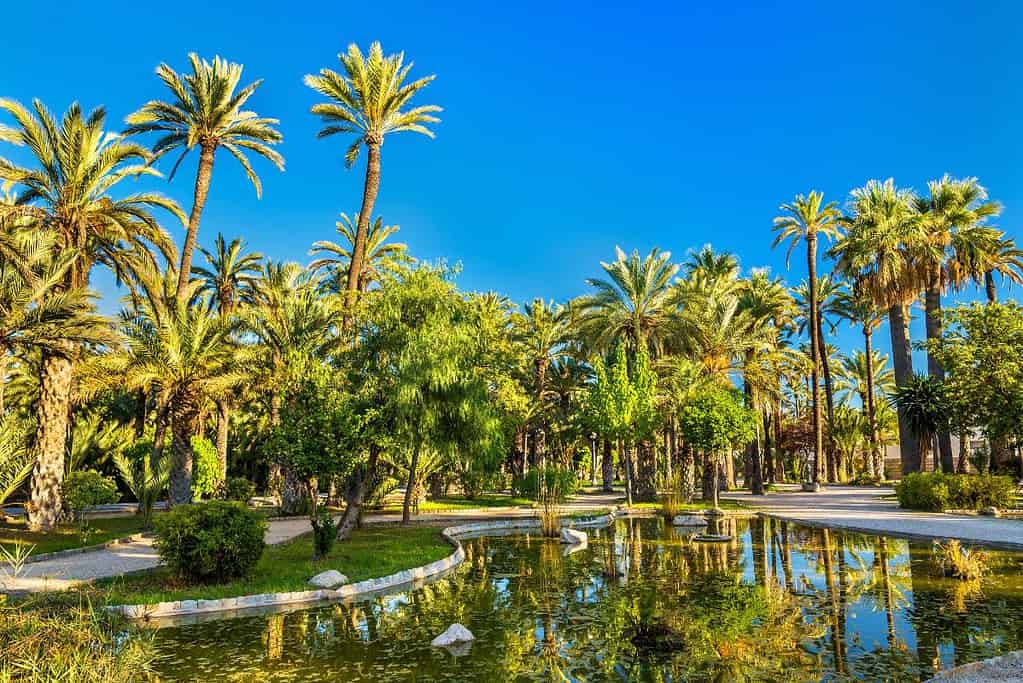
The Palmeral of Elche is a UNESCO World Heritage Site in Elche, Spain. It is a vast palm grove covering over 200 hectares, making it the largest palm grove in Europe. The grove is a unique cultural landscape shaped by human intervention over centuries. It features thousands of palm trees, some centuries-old, and an intricate network of canals, wells, and irrigation systems that have sustained the grove’s agricultural activities. The Palmeral of Elche is a remarkable example of harmonious coexistence between humans and nature. Still, it also carries significant historical and cultural value, reflecting the influence of different civilizations throughout history.
Paseo del Prado and Buen Retiro, a landscape of Arts and Sciences
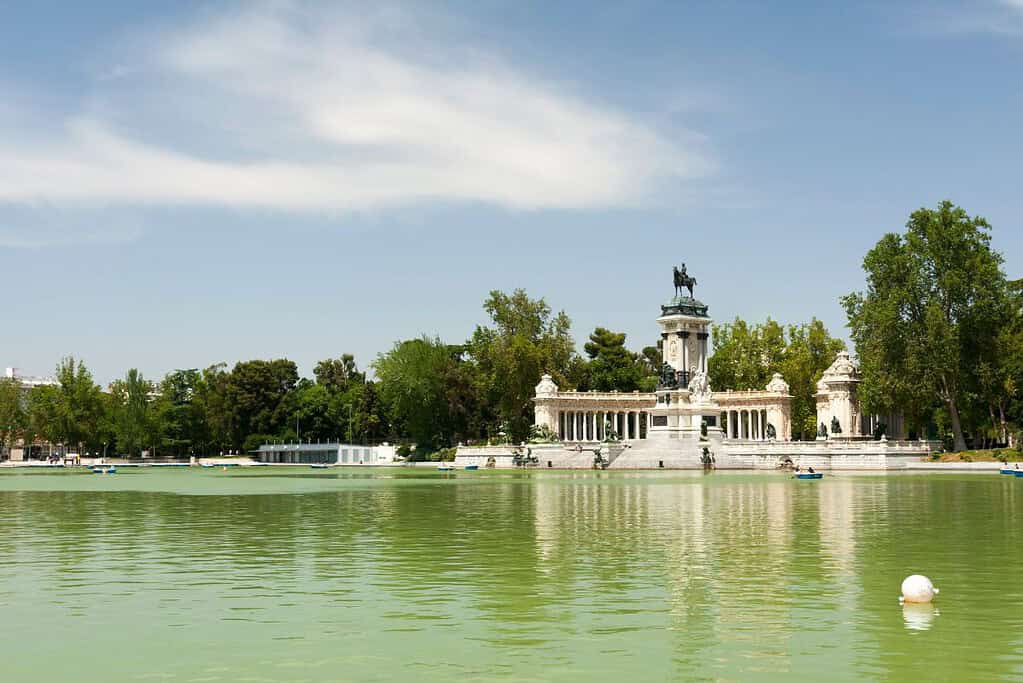
Paseo del Prado and Buen Retiro, a landscape of Arts and Sciences, is a UNESCO World Heritage Site in Spain. This enchanting area in Madrid showcases a remarkable blend of natural beauty and cultural significance. The Paseo del Prado boulevard has stunning architectural masterpieces, such as the Prado Museum and the Thyssen-Bornemisza Museum, which house renowned art collections. Adjacent to this historic promenade lies the Buen Retiro Park, a tranquil oasis filled with lush gardens, serene ponds, and grand monuments. The park’s iconic Crystal Palace and its beautiful boating lake further enhance the harmonious fusion of nature and artistic expression. Paseo del Prado and Buen Retiro provide visitors with a captivating journey through the arts, sciences, and the surrounding natural splendor.
Poblet Monastery
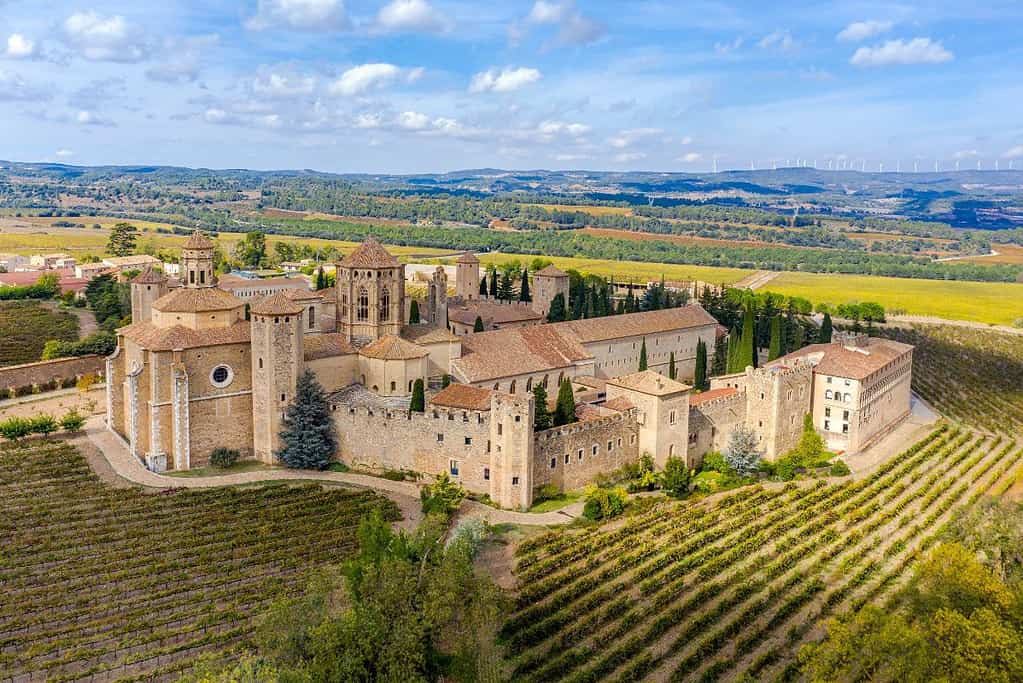
Poblet Monastery, located in Catalonia, Spain, is a UNESCO World Heritage Site of great historical and cultural significance. The monastery, founded in the 12th century, is a remarkable example of Cistercian architecture and serves as a testament to the religious and artistic heritage of the region. Its impressive Gothic and Romanesque structures, including the church, cloister, and royal tombs, showcase the monastery’s rich history. Poblet Monastery stands as a symbol of spirituality, craftsmanship, and the enduring legacy of the Cistercian order.
Prehistoric Rock Art Sites in the Côa Valley and Siega Verde
The Prehistoric Rock Art Sites in the Côa Valley and Siega Verde are UNESCO World Heritage Sites in Portugal and Spain respectively. These sites contain remarkable collections of rock art that date back thousands of years, providing valuable insights into the lives and beliefs of prehistoric communities. The rock art features intricate engravings and paintings depicting various animals, human figures, and abstract symbols. These extraordinary artworks showcase our ancient ancestors’ creativity and cultural heritage, making these sites of immense archaeological and historical importance. Exploring these mesmerizing landscapes allows visitors to connect with the past and appreciate the rich artistic traditions of early human civilizations.
Renaissance Monumental Ensembles of Úbeda and Baeza
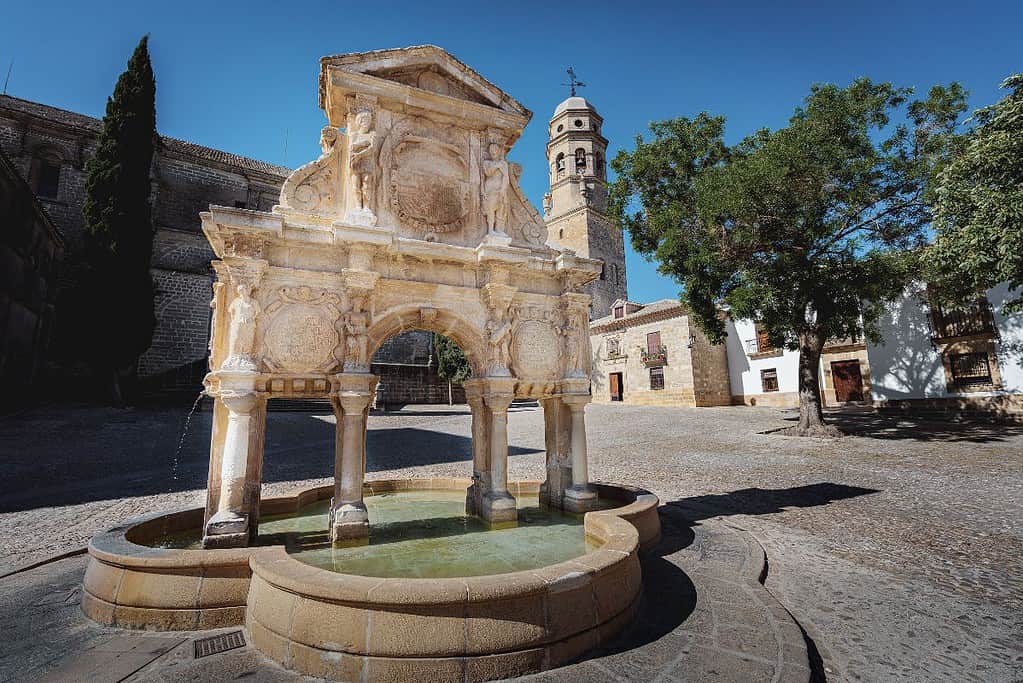
The Renaissance Monumental Ensembles of Úbeda and Baeza are UNESCO World Heritage Sites located in Jaén, Spain. These two towns are renowned for their exceptional Renaissance architecture, reflecting the rich cultural and artistic heritage of the 16th century. Úbeda and Baeza boast numerous monumental buildings, including churches, palaces, and squares, that beautifully showcase the harmonious blend of Gothic, Mudéjar, and Renaissance styles. These structures’ intricate facades, grand courtyards, and ornate details transport visitors to an era of artistic brilliance and cultural flourishing. The Renaissance Monumental Ensembles of Úbeda and Baeza stand as a testament to Spain’s architectural legacy and are treasured landmarks that attract admirers worldwide.
Risco Caido and the Sacred Mountains of Gran Canaria Cultural Landscape
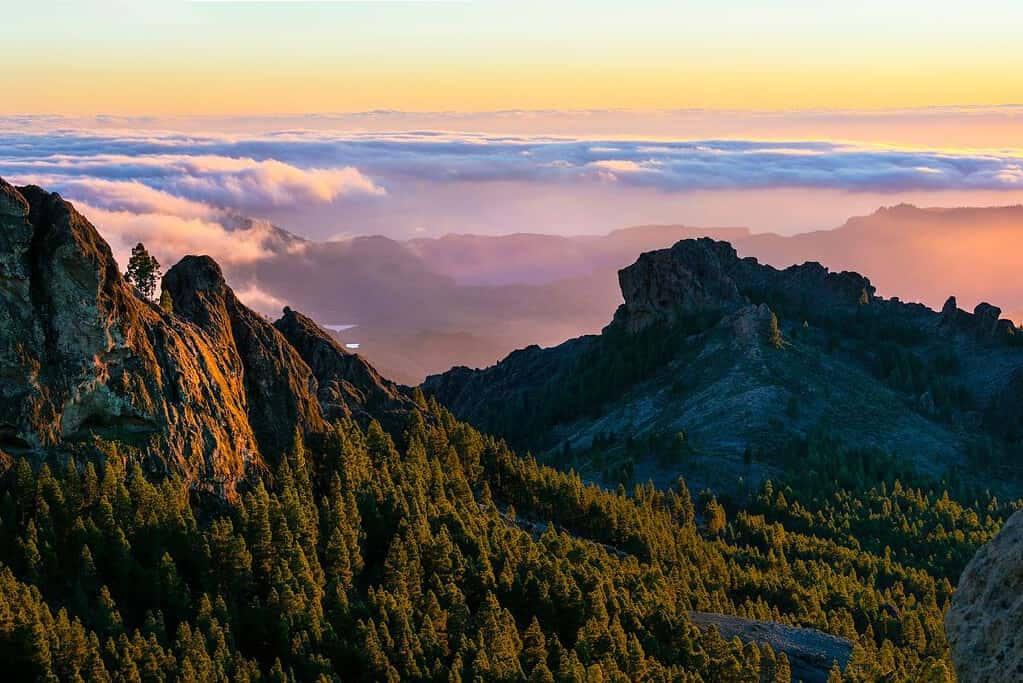
Risco Caido and the Sacred Mountains of Gran Canaria Cultural Landscape is a UNESCO World Heritage Site in Gran Canaria, Spain. This unique cultural landscape showcases the remarkable connection between nature and the ancient indigenous communities of the Canary Islands. The site comprises cliffs, caves, and ravines, vital for survival and held profound religious and astronomical significance for the pre-Hispanic people. One of the standout features is the Risco Caido, a cliff adorned with intricate rock carvings and a sacred astronomical observatory. This exceptional landscape offers a glimpse into the ancient Canarian civilization’s rich spiritual and cultural heritage.
Rock Art of the Mediterranean Basin on the Iberian Peninsula
The Rock Art of the Mediterranean Basin on the Iberian Peninsula is a UNESCO World Heritage Site in Spain. It showcases a rich and diverse collection of prehistoric rock art dating back thousands of years. These extraordinary cave paintings and engravings provide invaluable insights into the lives and beliefs of the region’s early inhabitants. The site is a testament to the ancient Mediterranean civilizations’ exceptional artistic and cultural legacy, capturing their creativity, symbolism, and connection to the natural world. Exploring this unique archaeological treasure offers a captivating journey through time and a deep appreciation for the human capacity for artistic expression.
Roman Walls of Lugo
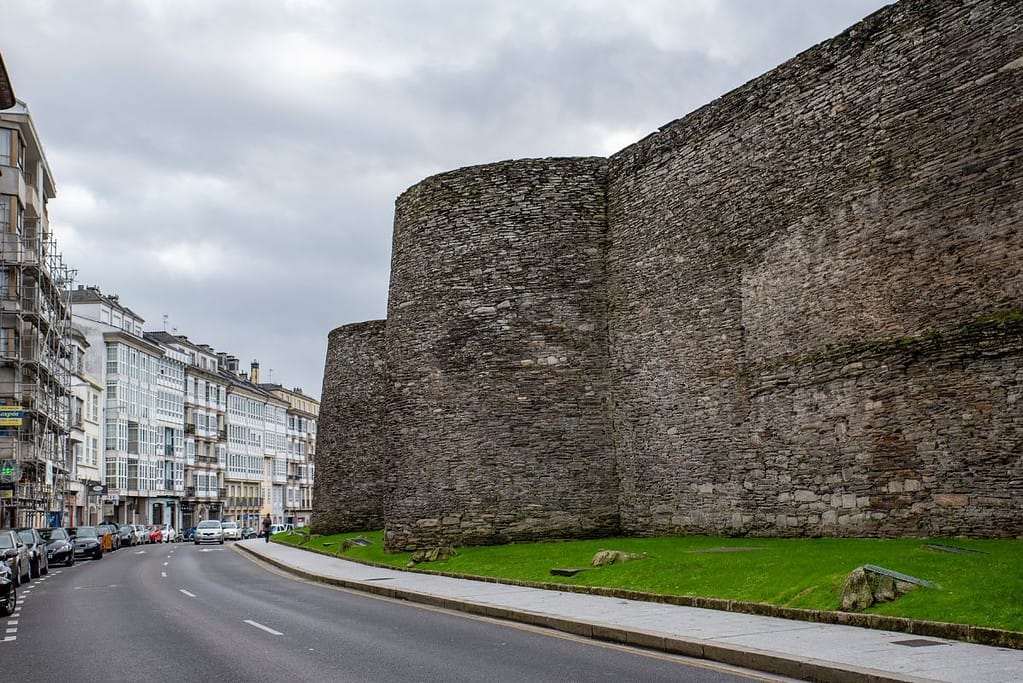
The Roman Walls of Lugo, a UNESCO World Heritage Site located in the city of Lugo, Spain, is an exceptional testament to the engineering and architectural achievements of the Roman Empire. Built-in the late 3rd century, these magnificent walls encircle the historic center of Lugo, spanning a length of 2.1 kilometers and reaching heights of up to 10 meters. The walls consist of 85 towers and ten gates, offering visitors a glimpse into the city’s ancient past and providing a remarkable example of Roman military fortification. The Roman Walls of Lugo stand as a remarkable heritage site, showcasing the enduring legacy of Roman civilization in this picturesque corner of Spain.
Routes of Santiago de Compostela: Camino Francés and Routes of Northern Spain
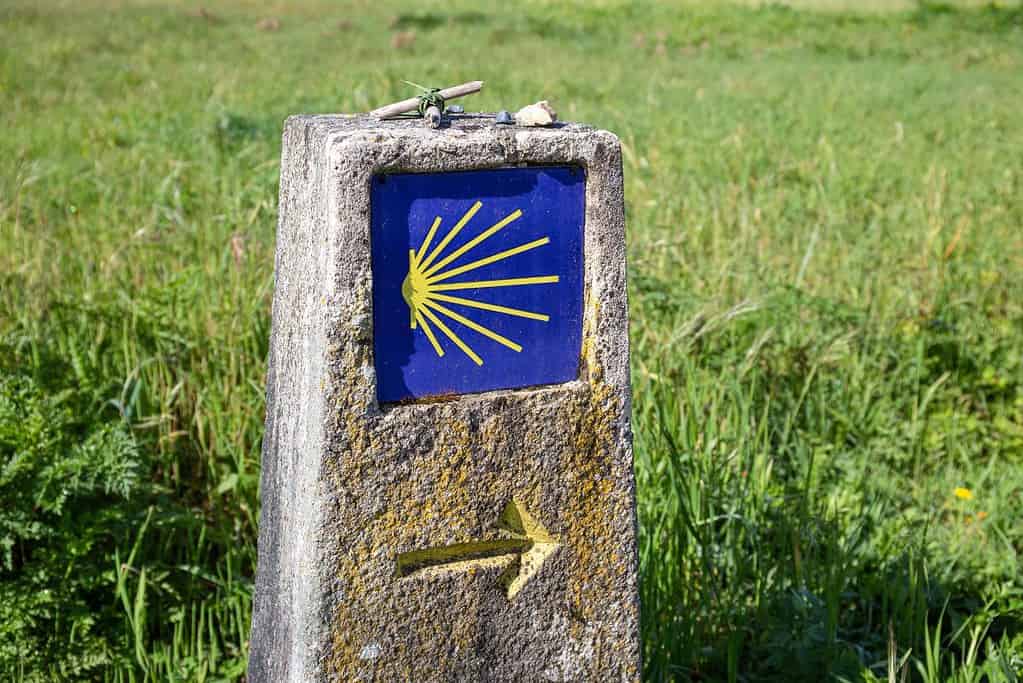
The Routes of Santiago de Compostela: Camino Francés and Routes of Northern Spain is a UNESCO World Heritage Site in Spain. This site is of great cultural and religious significance, encompassing a network of pilgrimage routes leading to Santiago de Compostela. The most renowned route is the Camino Francés, which starts in the French Pyrenees and traverses various landscapes and historical towns before reaching Santiago. Along the way, pilgrims can experience stunning natural beauty, encounter diverse architectural styles, and immerse themselves in centuries-old traditions. The site also includes other routes in Northern Spain, each offering unique cultural, historical, and spiritual experiences for pilgrims worldwide.
Royal Monastery of Santa María de Guadalupe
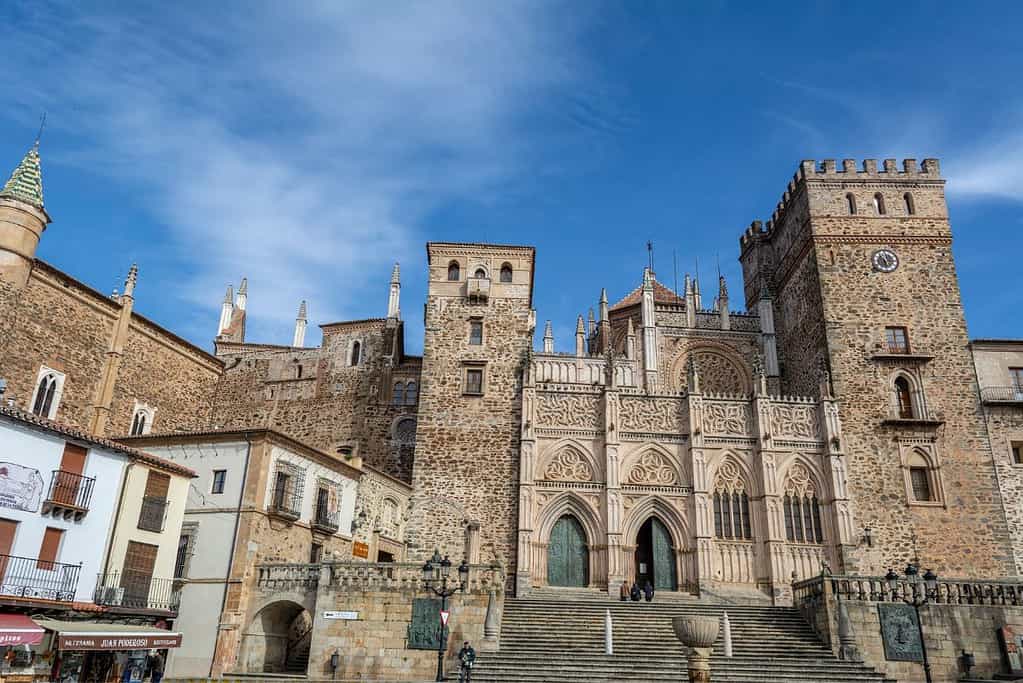
The Royal Monastery of Santa María de Guadalupe is a UNESCO World Heritage Site in Guadalupe, Spain. This magnificent monastery holds great historical and cultural significance. It was founded in the 14th century and has been a symbol of religious devotion and pilgrimage for centuries. The monastery showcases a blend of architectural styles, with elements of Gothic, Mudéjar, and Renaissance influences. Its intricate stone carvings, beautiful cloisters, and the stunning Chapel of Our Lady of Guadalupe are just a few of the architectural treasures within its walls. The Royal Monastery of Santa María de Guadalupe is a testament to Spain’s rich heritage. It continues to be a place of spiritual importance for visitors worldwide.
San Cristóbal de La Laguna
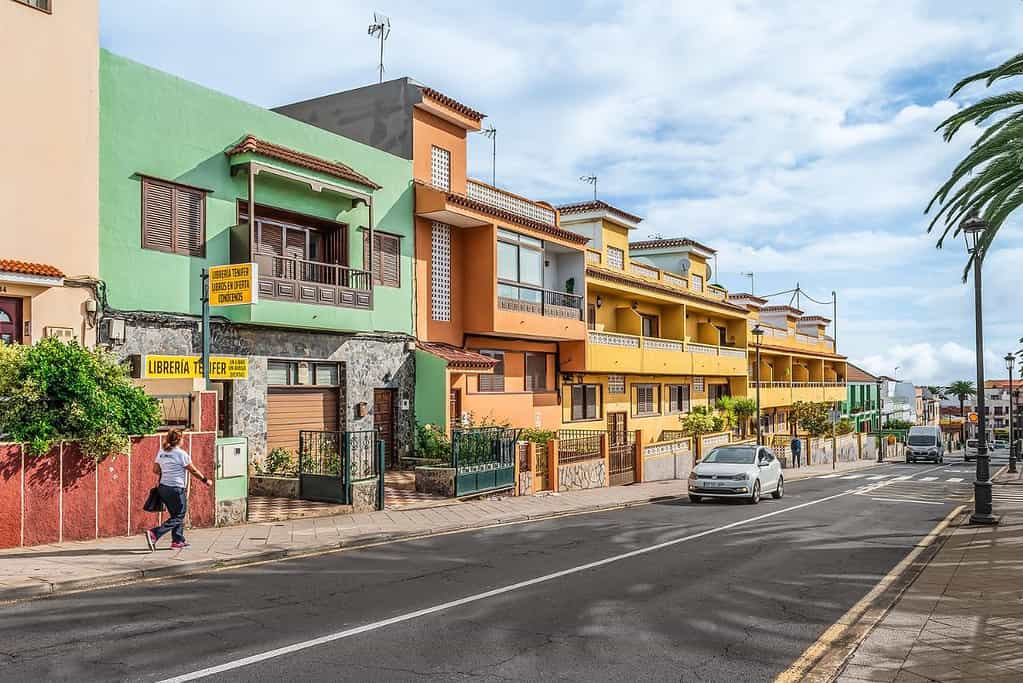
San Cristóbal de La Laguna, located in Tenerife, Canary Islands, is a UNESCO World Heritage Site. This historic town is renowned for its exceptional architectural and urban layout, representing the best-preserved example of a colonial town from the 15th to 16th centuries. The city’s streets are lined with elegant and well-preserved buildings that showcase a harmonious blend of Gothic, Renaissance, and traditional Canarian architectural styles. With its picturesque plazas, charming churches, and historical landmarks, San Cristóbal de La Laguna offers visitors a glimpse into the rich cultural heritage of the Canary Islands and stands as a testament to the island’s historical significance.
San Millán Yuso and Suso Monasteries
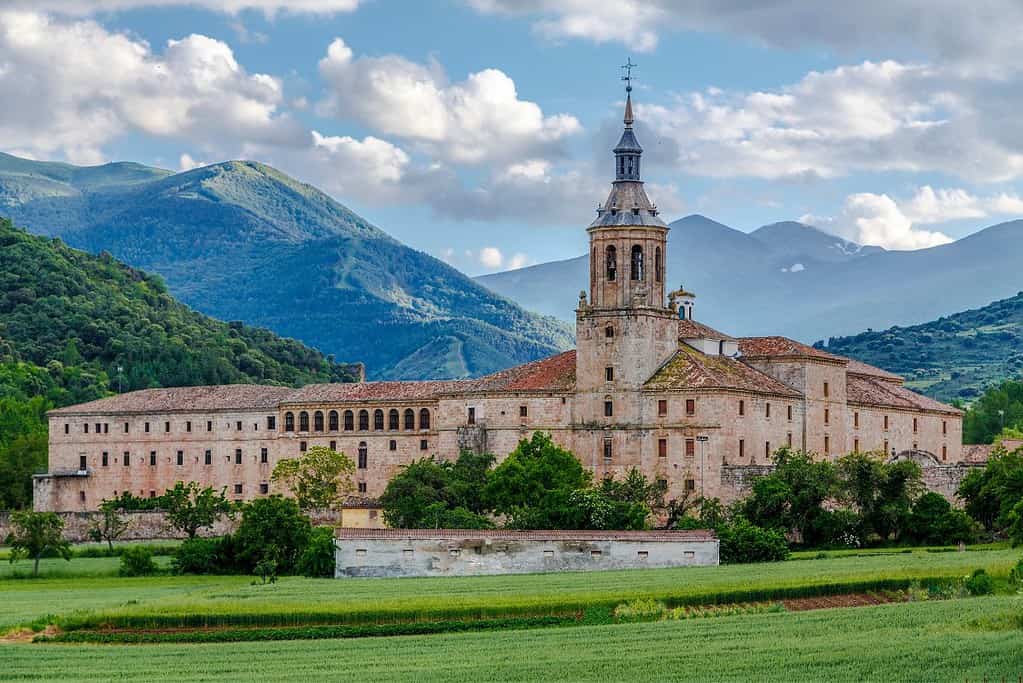
San Millán Yuso and Suso Monasteries in La Rioja, Spain, are recognized as UNESCO World Heritage Sites. These monasteries hold significant historical and cultural importance. Suso Monastery, the older of the two, dates back to the 6th century and played a pivotal role in the spread of the Spanish language. San Millán Yuso Monastery, built in the 11th century, showcases stunning Romanesque and Baroque architecture. These monasteries offer a glimpse into the region’s rich religious and linguistic heritage, making them a must-visit destination for history and culture enthusiasts alike.
Santiago de Compostela (Old Town)
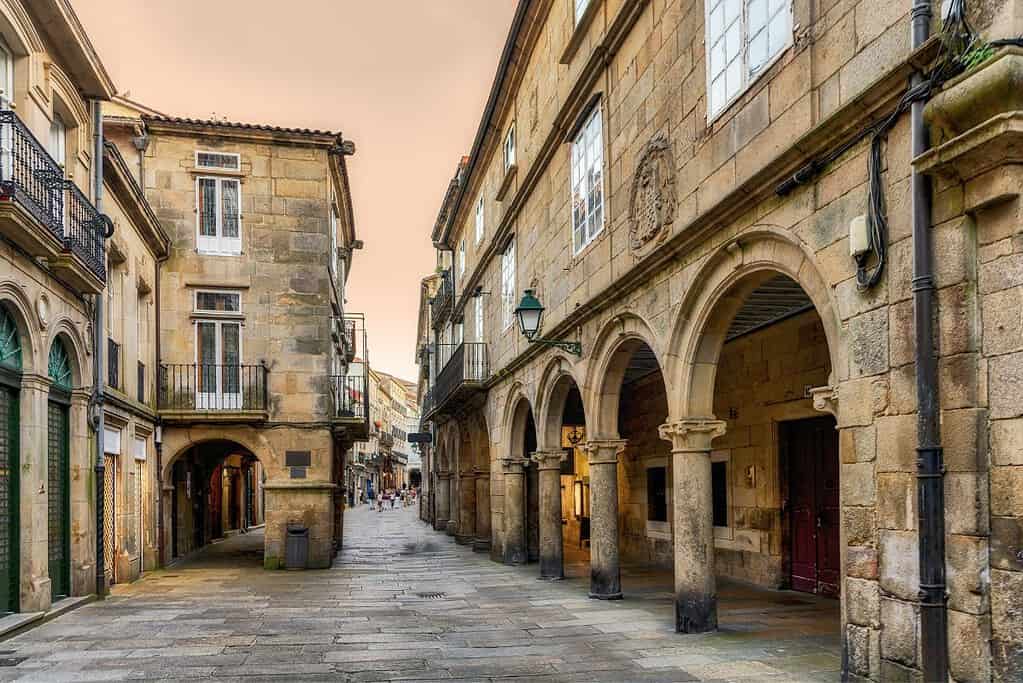
Santiago de Compostela’s Old Town is a UNESCO World Heritage Site in northwest Spain. It is renowned as one of the most important pilgrimage destinations in the world. The Old Town’s historic center is dominated by the magnificent Santiago de Compostela Cathedral, a Romanesque and Baroque architectural masterpiece. Pilgrims have been journeying to this sacred site for centuries, following the Camino de Santiago, a network of pilgrimage routes. The Old Town is a charming labyrinth of narrow streets, picturesque squares, and historic buildings, preserving its medieval character and offering visitors a unique glimpse into the city’s rich cultural and religious heritage.
Tower of Hercules
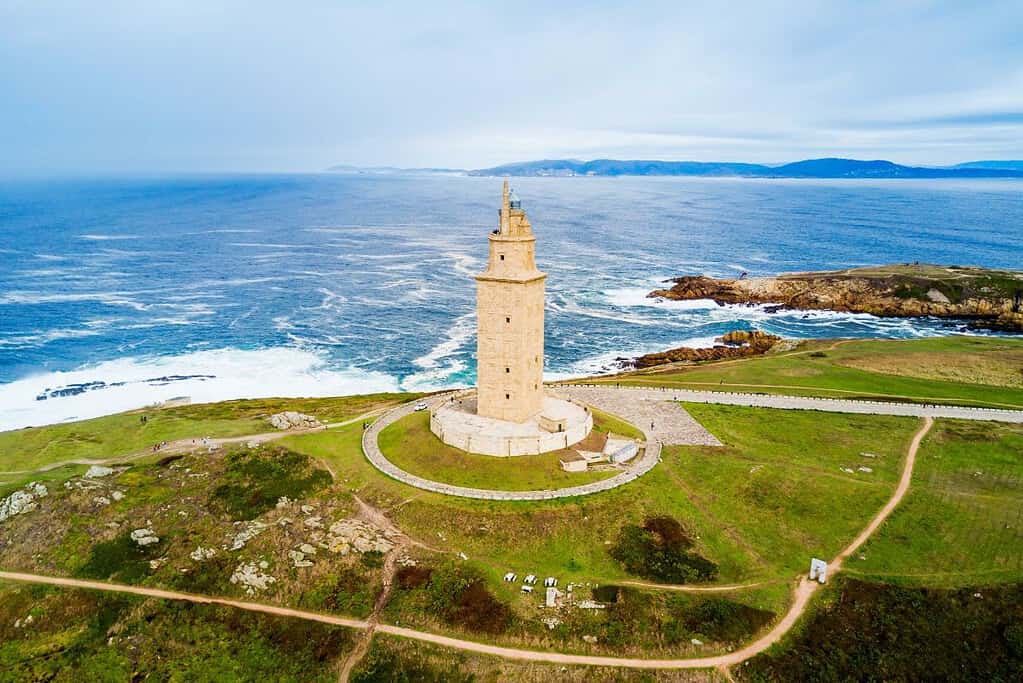
The Tower of Hercules is a UNESCO World Heritage Site in A Coruña, Spain. It is an ancient Roman lighthouse and one of the oldest functioning lighthouses in the world. Standing tall at around 55 meters, the tower overlooks the Atlantic Ocean and has been a guiding beacon for ships for over two millennia. Its architectural design and historical significance make it a remarkable symbol of the region’s maritime heritage. The Tower of Hercules continues to be an iconic landmark, attracting visitors captivated by its historical significance and breathtaking views of the surrounding coastline.
University and Historic Precinct of Alcalá de Henares
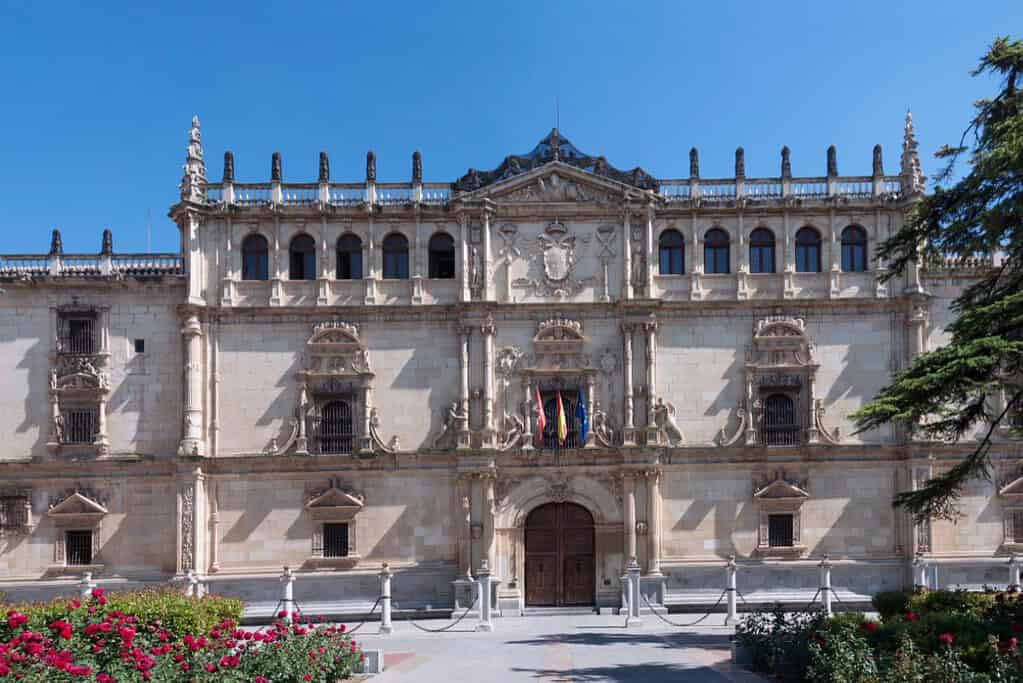
The University and Historic Precinct of Alcalá de Henares is a UNESCO World Heritage Site in Alcalá de Henares, Spain. This site holds significant cultural and historical importance as it is home to one of the oldest universities in the world, the University of Alcalá. Founded in 1499, the university boasts a rich academic legacy and has played a vital role in disseminating knowledge throughout the centuries. The historic precinct surrounding the university features stunning architectural landmarks, including the Cervantes Birthplace Museum, where the renowned writer Miguel de Cervantes was born. With its well-preserved buildings, charming streets, and cultural heritage, the University and Historic Precinct of Alcalá de Henares offers visitors a captivating journey into Spain’s academic and literary history.
Vizcaya Bridge

The Vizcaya Bridge is a remarkable UNESCO World Heritage Site in the Basque Country of Spain. This architectural marvel is an iconic transporter bridge that spans the Nervion River, connecting the towns of Portugalete and Las Arenas. Designed by Alberto Palacio, the bridge was completed in 1893 and represents a pioneering engineering feat. The Vizcaya Bridge is not only a functional transportation link but also a testament to the ingenuity and innovation of its era. With its unique design featuring a gondola suspended from a structure of ironwork, the bridge offers breathtaking panoramic views. It continues to captivate visitors with its historical significance and impressive engineering prowess.
Works of Antoni Gaudí
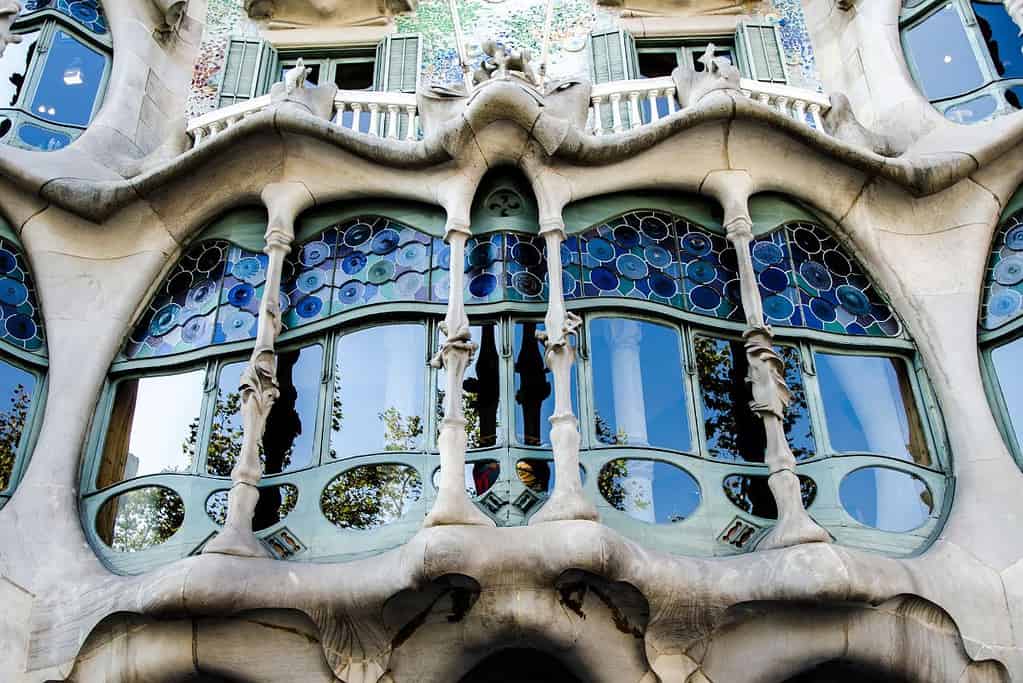
The Works of Antoni Gaudí is a collection of iconic architectural masterpieces recognized as a UNESCO World Heritage Site. Located in Barcelona, Spain, these extraordinary creations are a testament to the genius of Antoni Gaudí, a renowned Catalan architect. Gaudí’s distinctive style, Catalan Modernism or Art Nouveau, is characterized by its imaginative shapes, vibrant colors, and intricate details. Among his most famous works are the Sagrada Família, Park Güell, and Casa Batlló. These structures showcase Gaudí’s innovative use of materials and harmonious integration of nature and architecture. Visiting the Works of Antoni Gaudí is like stepping into a surreal and enchanting world where art, spirituality, and imagination converge.
Ancient and Primeval Beech Forests of the Carpathians and Other Regions of Europe
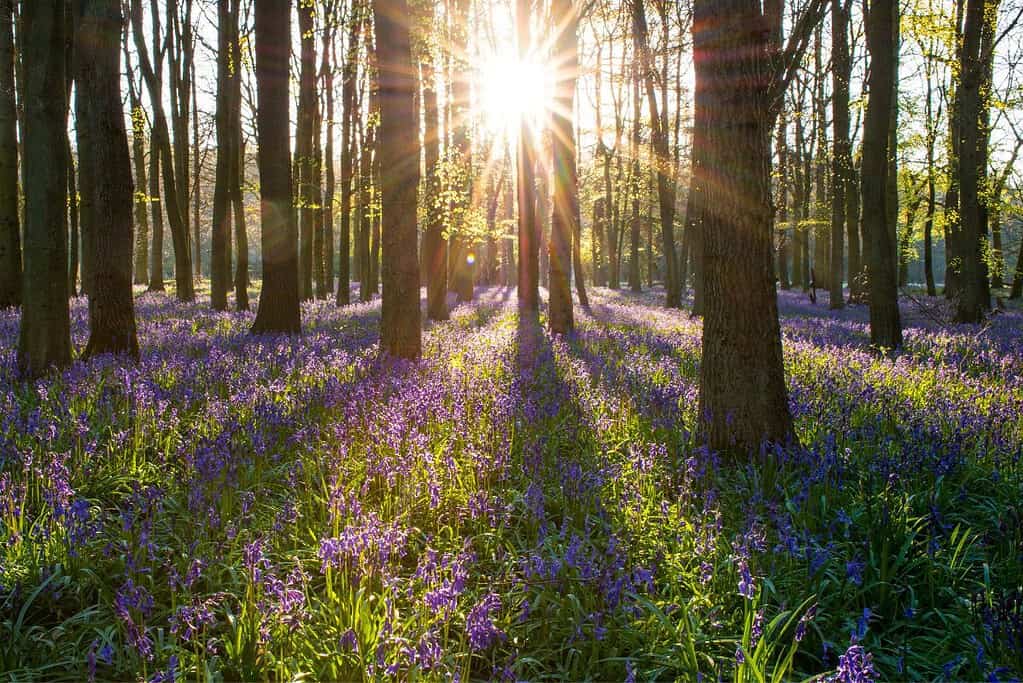
The Ancient and Primeval Beech Forests of the Carpathians and Other Regions of Europe is a remarkable UNESCO World Heritage Site. It spans several European countries and showcases the enduring beauty of beech forests in their untouched and pristine form. These ancient forests have survived for centuries, providing vital habitats for diverse flora and fauna. The site encompasses a variety of ecosystems, including towering trees, lush undergrowth, and vibrant wildlife. It serves as a living testament to these majestic beech forests’ ecological and historical significance, ensuring their preservation for future generations to admire and cherish.
Doñana National Park
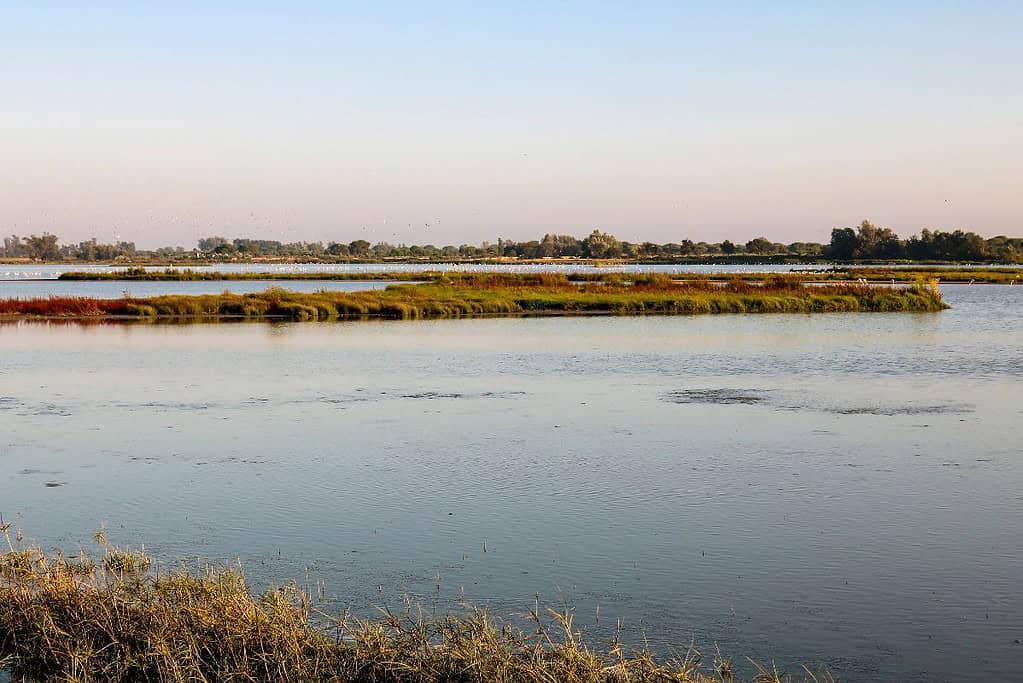
Doñana National Park is a UNESCO World Heritage Site located in southwestern Spain. This exceptional park is renowned for its remarkable biodiversity and unique ecosystems. Spanning over 54,000 hectares, it encompasses diverse habitats such as marshes, dunes, and lagoons, making it a haven for numerous bird species. Doñana National Park is a vital stopover for migratory birds and a breeding ground for endangered species like the Iberian lynx and the Spanish imperial eagle. Its extraordinary natural beauty, rich wildlife, and important ecological value make Doñana National Park a true conservation treasure and a delight for nature enthusiasts.
Garajonay National Park
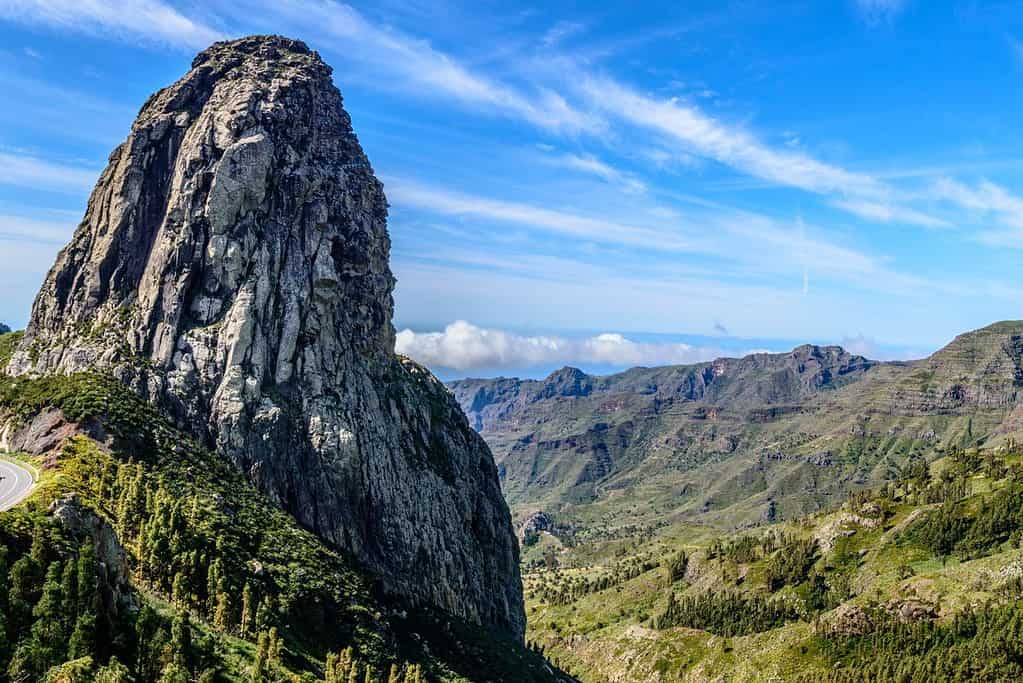
Garajonay National Park is a UNESCO World Heritage Site in the Canary Islands, Spain. This unique park covers an area of over 4,000 hectares and is known for its lush and ancient laurel forest. It showcases a remarkable ecosystem that has remained virtually unchanged for millions of years. The park is home to many plant and animal species, some found nowhere else on Earth. Visitors to Garajonay National Park can explore its enchanting trails, admire breathtaking viewpoints, and immerse themselves in this exceptional site’s natural beauty and tranquility.
Teide National Park

Teide National Park, located in Tenerife, Spain, is a UNESCO World Heritage Site renowned for its breathtaking natural beauty and geological significance. The park is dominated by Mount Teide, a majestic stratovolcano that stands as the highest peak in Spain and the third tallest volcano on Earth. Rugged volcanic formations, dramatic lava fields, and vibrant biodiversity characterize its unique landscape. Visitors to Teide National Park can explore its diverse ecosystems, including forests of ancient Canary Island pine trees and other endemic flora and fauna. The park also offers mesmerizing panoramic views of the surrounding islands and the Atlantic Ocean, making it a must-visit destination for nature enthusiasts and hikers alike.
Ibiza, Biodiversity and Culture
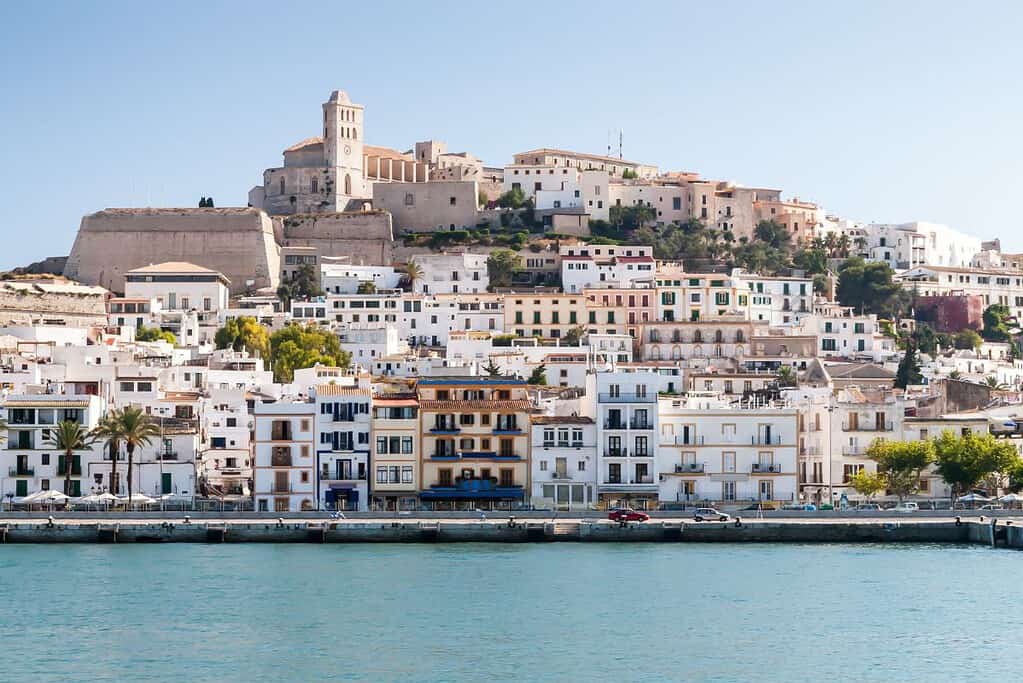
Ibiza, Biodiversity, and Culture is a UNESCO World Heritage Site in Spain’s Balearic Islands. This site is renowned for its unique combination of rich biodiversity and vibrant cultural heritage. The island of Ibiza showcases diverse ecosystems, including coastal and marine areas, forests, and wetlands, which support various plant and animal species. Moreover, Ibiza’s cultural heritage is deeply rooted in its history as a crossroads of civilizations, with traces of Phoenician, Roman, Islamic, and Catalan influences evident throughout the island. The fusion of natural beauty and cultural significance makes Ibiza a captivating destination that attracts visitors from around the world.
Pyrénées – Mont Perdu
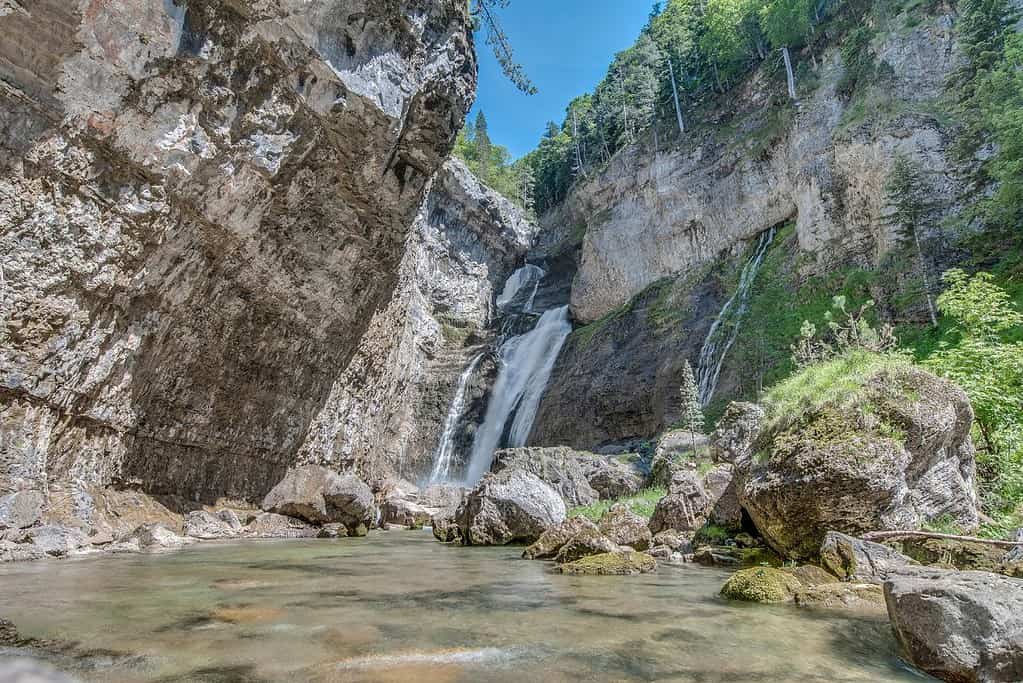
Pyrénées – Mont Perdu is a UNESCO World Heritage Site located in the Pyrénées mountain range, straddling the border between France and Spain. This stunning natural site encompasses rugged peaks, deep valleys, and glacial landscapes, offering breathtaking views and a rich biodiversity. Mont Perdu, standing at an impressive height of 3,352 meters, is the centerpiece of the site and is revered for its majestic beauty. The area is also known for its cultural heritage, with ancient pastoral traditions and historic villages that have preserved their unique architectural style. Pyrénées – Mont Perdu is a paradise for nature lovers, hikers, and those seeking a profound connection with the awe-inspiring power of the mountains.
Spain UNESCO tentative list
- Romanesque Cultural Enclave in the North of Castile-Leon and the South of Cantabria
- Bulwarked Frontier Fortifications
- The Silver Route
- Mediterranean Wind Mills
- Greek Archaeological ensemble in Empúries, l’Escala, Girona
- The Ribeira Sacra, Lugo and Orense
- The Mediterranean Facet of the Pyrenees (France-Spain)
- Talayotic Culture of Minorca
- Mesta Livestock trails
- Roman Ways. Itineraries of the Roman Empire
- Ancares – Somiedo
- Loarre Castle
- El Ferrol of the Illustration Historical Heritage
- Mining Historical Heritage
- Plasencia – Monfragüe – Trujillo : Paysage méditerranéen
- Jaén Cathedral (extension of the Renaissance Monumental Ensembles of Úbeda and Baeza)
- Valle Salado de Añana
- La Rioja and Rioja Alavesa Vine and Wine Cultural Landscape
- Priorat-Montsant-Siurana paysage agricole de la montagne méditerranéenne
- Le Portail du Monastère de Ripoll
- Turó de la Seu Vella de Lleida
- Monastery of Santa María de La Rábida and the Columbus Memorial Places in Huelva
- Church of San Salvador de Valdediós
- The Olive Grove Landscapes of Andalusia
- The Wine in Iberia
- Cíes Islands–Atlantic Islands of Galicia National Park
- The Hadrianic city of Italica
- Group of Mozarabic buildings on the Iberian Peninsula
- The Episcopal See of Egara and its pictorial decoration (5th-8th centuries)
- Les témoignages matériels de la construction de l’État des Pyrénées : la Co-principauté d’Andorre
- Sigüenza and Atienza Sweet and Salty Landscape
Tours in Spain
Our choices of tours in Spain are divided into thematic features such as Barcelona, Madrid, and Granada Experience.
